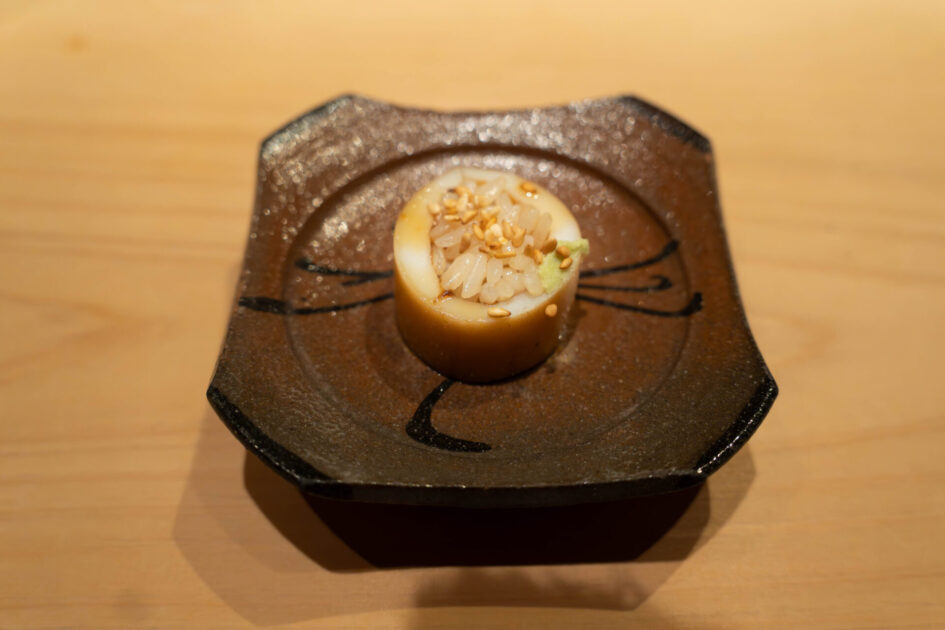CONTENTS
About Sushi Yasukichi
Concept
Quietly nestled in a corner near Hakata Station, “Sushi Yasukichi” welcomes guests with a serene atmosphere of pale wood counters and soft lighting beyond its gate.
The restaurant serves only one offering: a full omakase course. It begins with small dishes and delicacies that pair beautifully with sake, served in a graceful rhythm. The nigiri that follow are crafted with shari seasoned by a blend of vinegars, including akazu (red vinegar), and perfectly matched neta (fish), creating a sense of assured harmony.
Without any unnecessary flamboyance, the precision of the work and the beauty of its flow create a truly memorable dining experience.
About the Chef
Owner-chef Yasuhiko Shiiya entered the world of sushi at the age of 18 and opened “Sushi Yasukichi” when he was just 21.
His talent was recognized early—he earned two Michelin stars in 2014. Keiichi Nakazawa of “Sushi Sho” once called it “my favorite sushi restaurant in the world.”
Despite such acclaim, Chef Shiiya’s demeanor is calm and unpretentious. His quiet dedication radiates a powerful sense of conviction. He is also committed to training the next generation, firmly supporting Fukuoka’s sushi culture with his understated yet enduring presence.
Restaurant Recognition
In 2014, “Sushi Yasukichi” earned two Michelin stars in the Fukuoka edition of the Michelin Guide.
It also received the Tabelog Award Bronze Prize for four consecutive years from 2017 to 2020. Recognized in both gourmet media and user reviews, it’s often referred to as the work of a “genius of Hakata.”
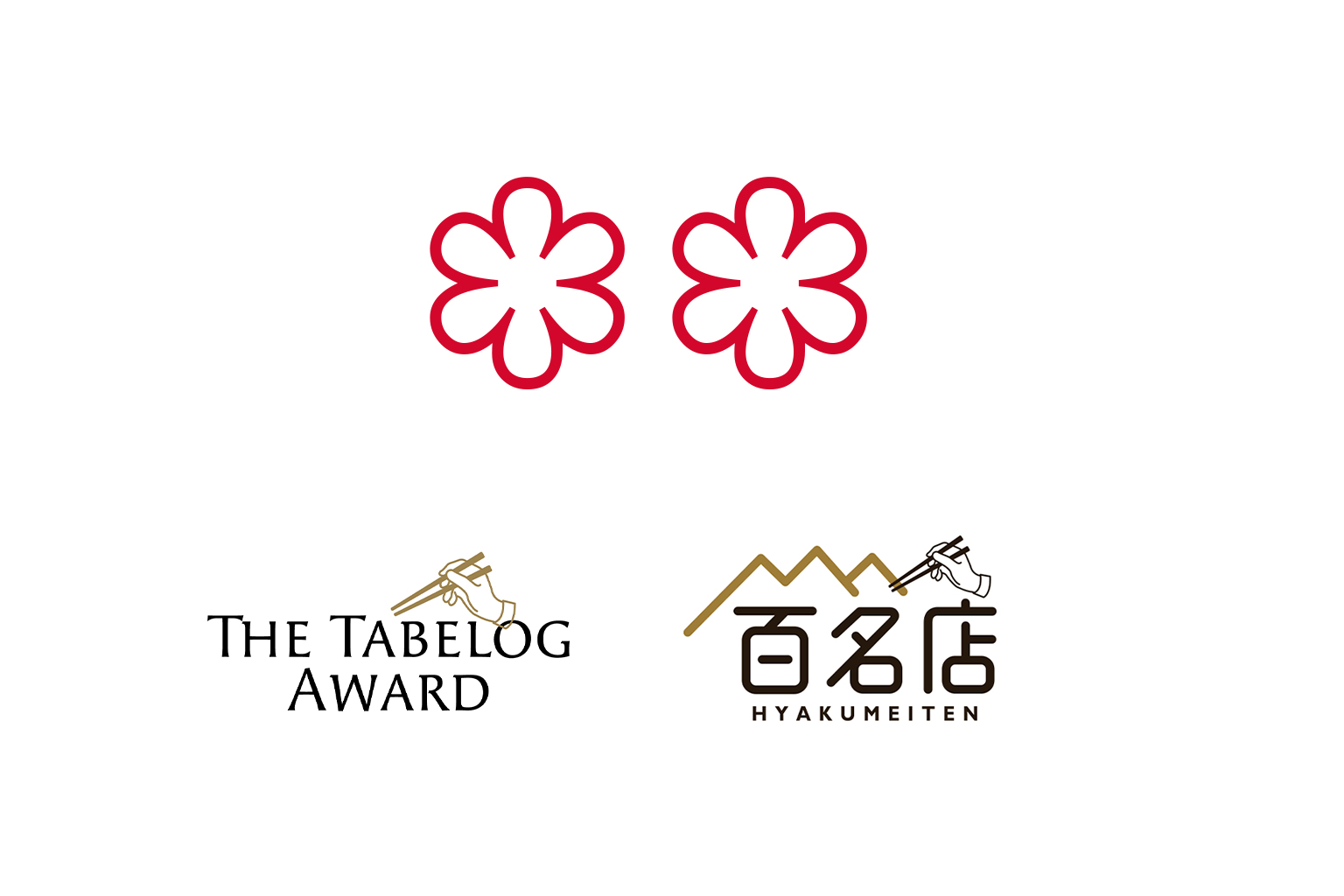
Dining Prelude
Exterior & Entrance
Located just off the bustle near Hakata Station, “Sushi Yasukichi” stands quietly as a detached house.
Its gate is stately yet modest, without any flashy signage—so discreet you might miss it at first glance. Passing through the latticed door, a small stone path framed by greenery leads you inward, instantly making you forget the urban surroundings.
The moment you step inside, you’re greeted by a composed space of pale wood counters and gentle lighting. The seamless transition from exterior tranquility to interior calm reflects the chef’s refined sense of hospitality.
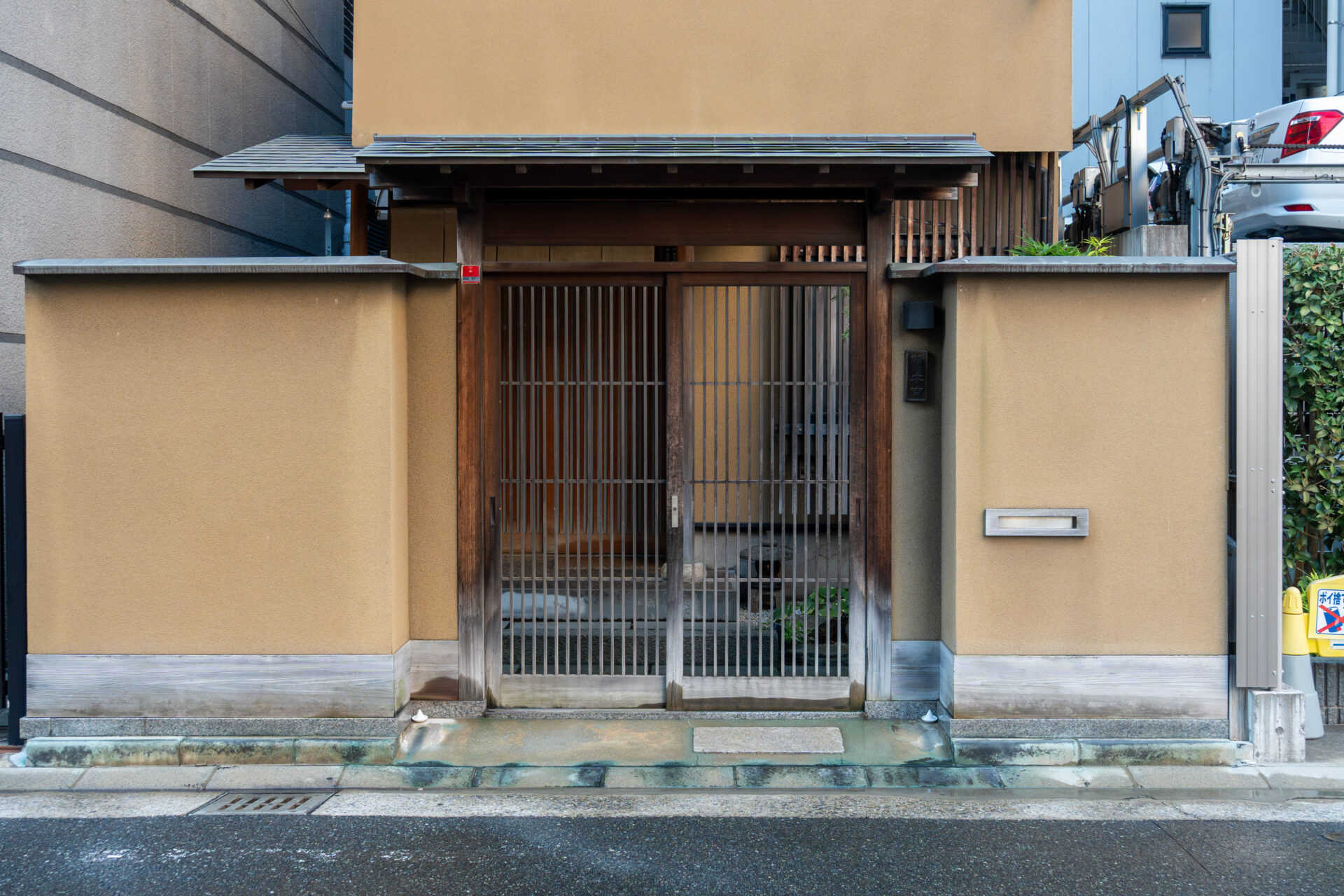
Dining Space
The interior centers around a single counter—crafted from one solid plank of white wood—with only seven seats. This intimate distance allows guests to face the chef directly. Lighting is soft and minimal, with no unnecessary decoration. It’s a space designed so that nothing distracts from the experience of each piece of sushi.
A single private room sits in the back, suitable for business or family use. The space overall feels serene and quietly tense, yet balanced with a subtle warmth. The understated, sincere design mirrors the chef’s own demeanor.
Starter Drink
The course begins with a cup of tea brewed personally by the chef over a traditional tea kettle.
He uses authentic hon-gyokuro from Yame in Fukuoka, extracted slowly at low temperature to draw out its umami and gentle sweetness. The temperature is carefully controlled, resulting in a clean, elegant finish with no bitterness.
It’s a quiet cup that centers the spirit before the sushi experience begins—setting the tone for what’s to come.
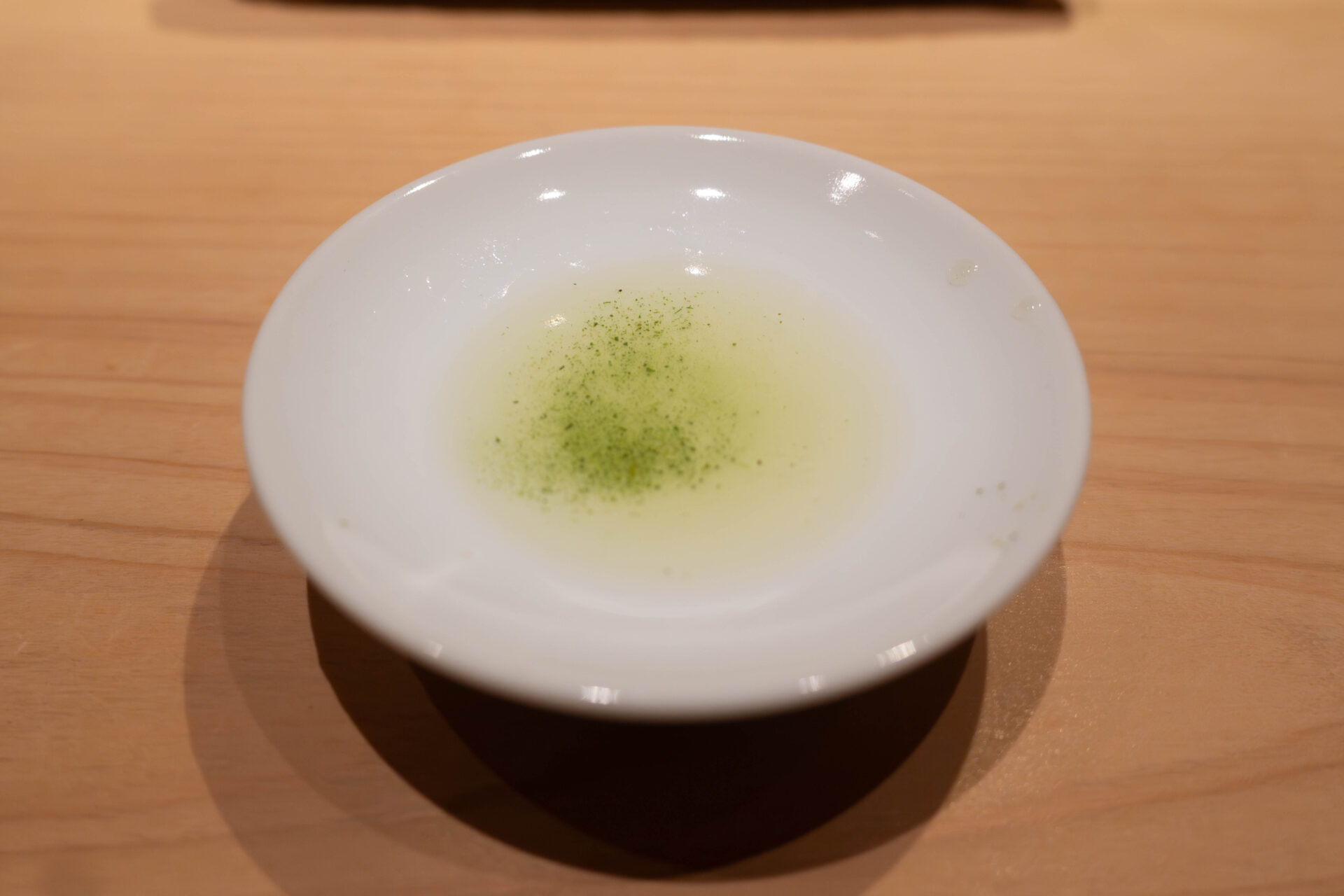
The Dishes Experienced
Ginnan (Ginkgo Nuts)
Following the opening cup of gyokuro tea came skewered ginkgo nuts.
Their fluffy texture carried the nutty aroma and gentle bitterness of autumn. Lightly roasted to draw out their natural flavor, they embodied a simple yet elegant start.
Though minimal in presentation, this small dish conveyed the change of seasons and quietly prepared the palate for the series of sake pairings and sushi to come.
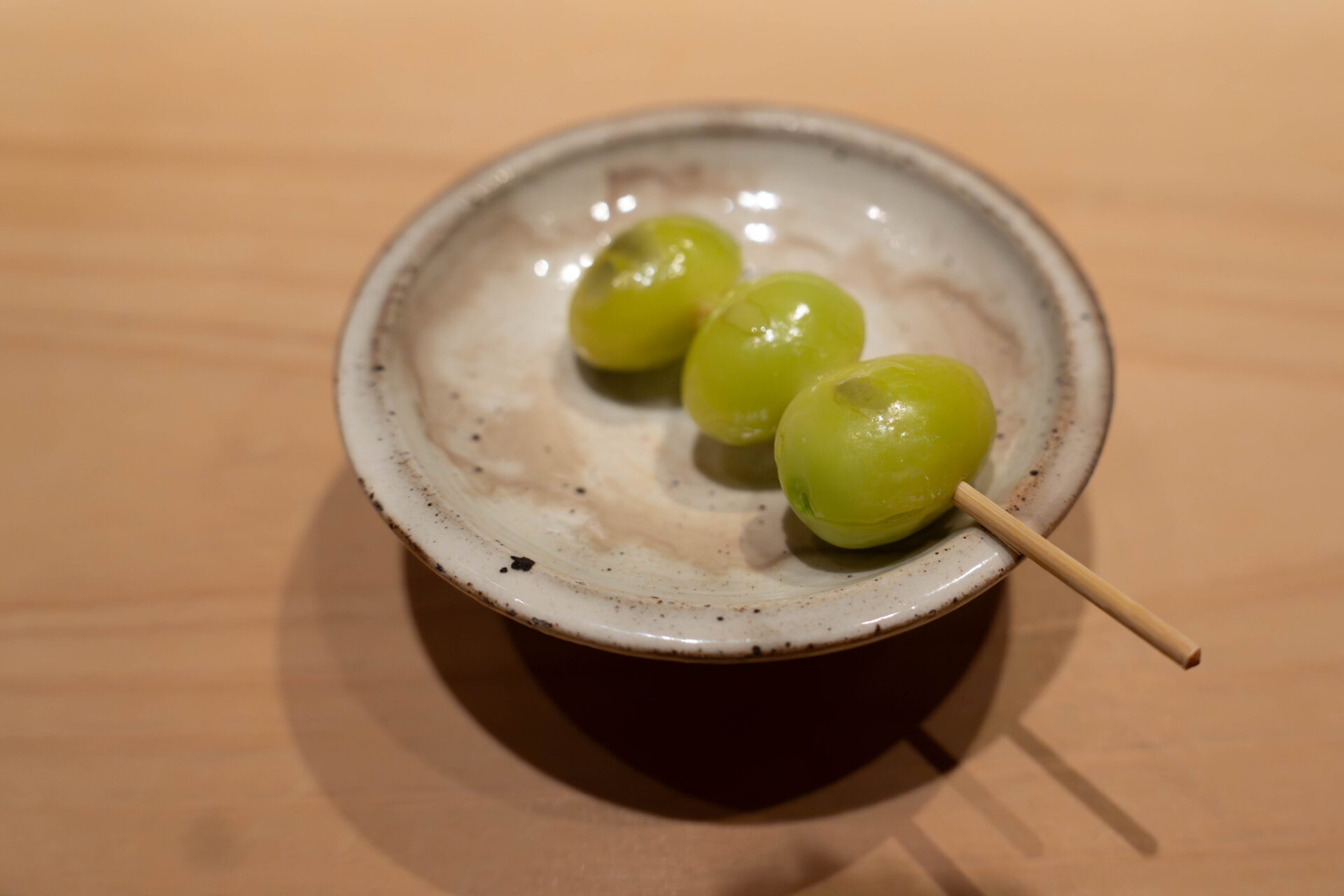
Ika no Inrōzume (Stuffed Squid)
Among the early appetizers, the most exciting dish was the stuffed squid.
Softly prepared squid was filled with sushi rice, topped with sesame and a hint of wasabi. Each bite revealed the sweetness of the squid, the gentle acidity of the rice, and the nutty fragrance of sesame.
A traditional Edomae-style technique rarely seen today, its appearance on the menu was a nostalgic and delightful surprise.
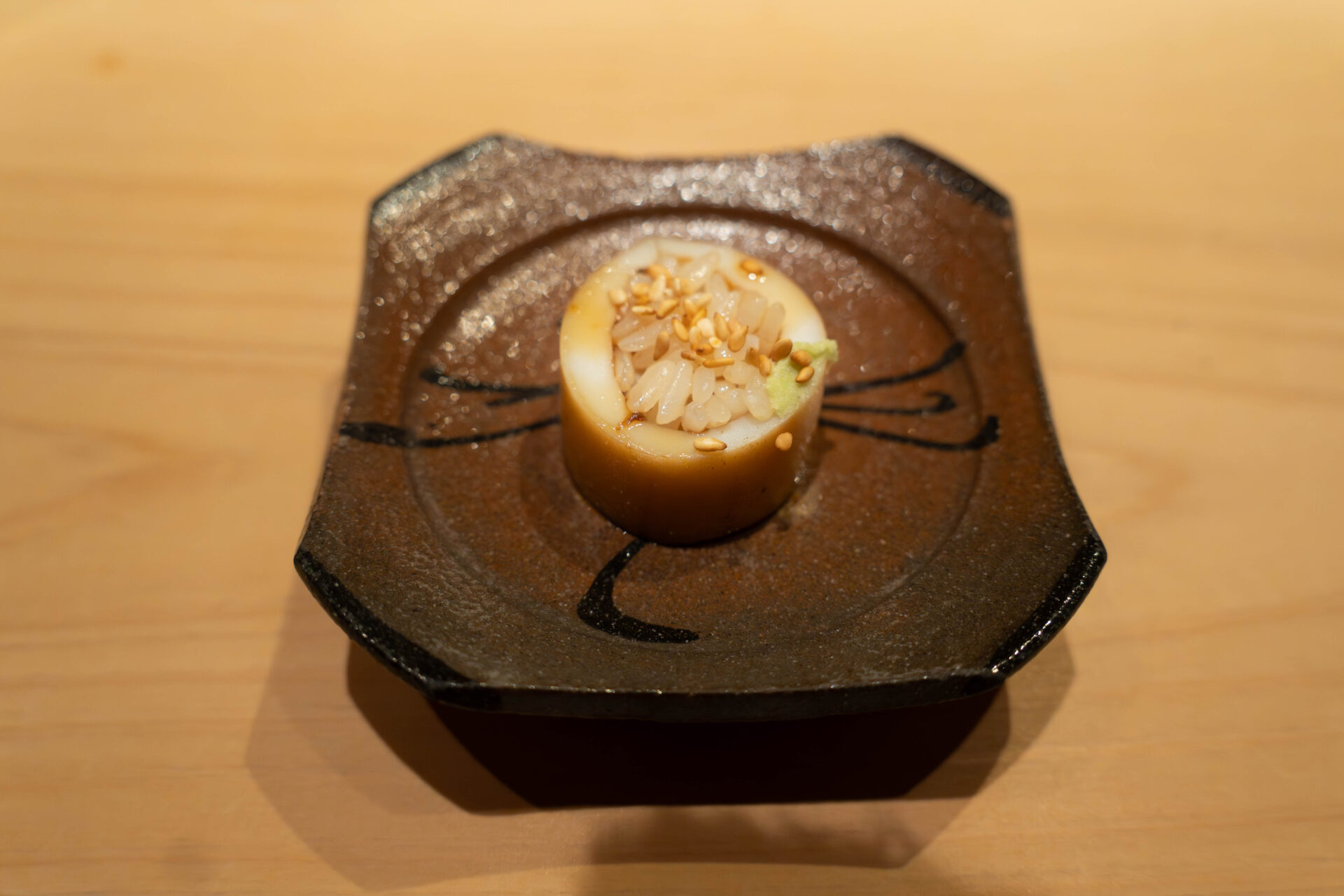
White Shrimp from Toyama and Grunt (Isaki)
Next came a plate of two small sashimi servings.
On the left, Toyama Bay’s white shrimp. Layered to create a silky, melt-in-the-mouth texture, finished with a touch of wasabi that lifted its sweetness.
On the right, slices of grunt (isaki) paired with salted kelp. This simple combination enhanced the fish’s natural sweetness with the umami of the seaweed and a delicate aroma of the ocean.
As pre-sushi appetizers, these dishes were light yet left a memorable impression.
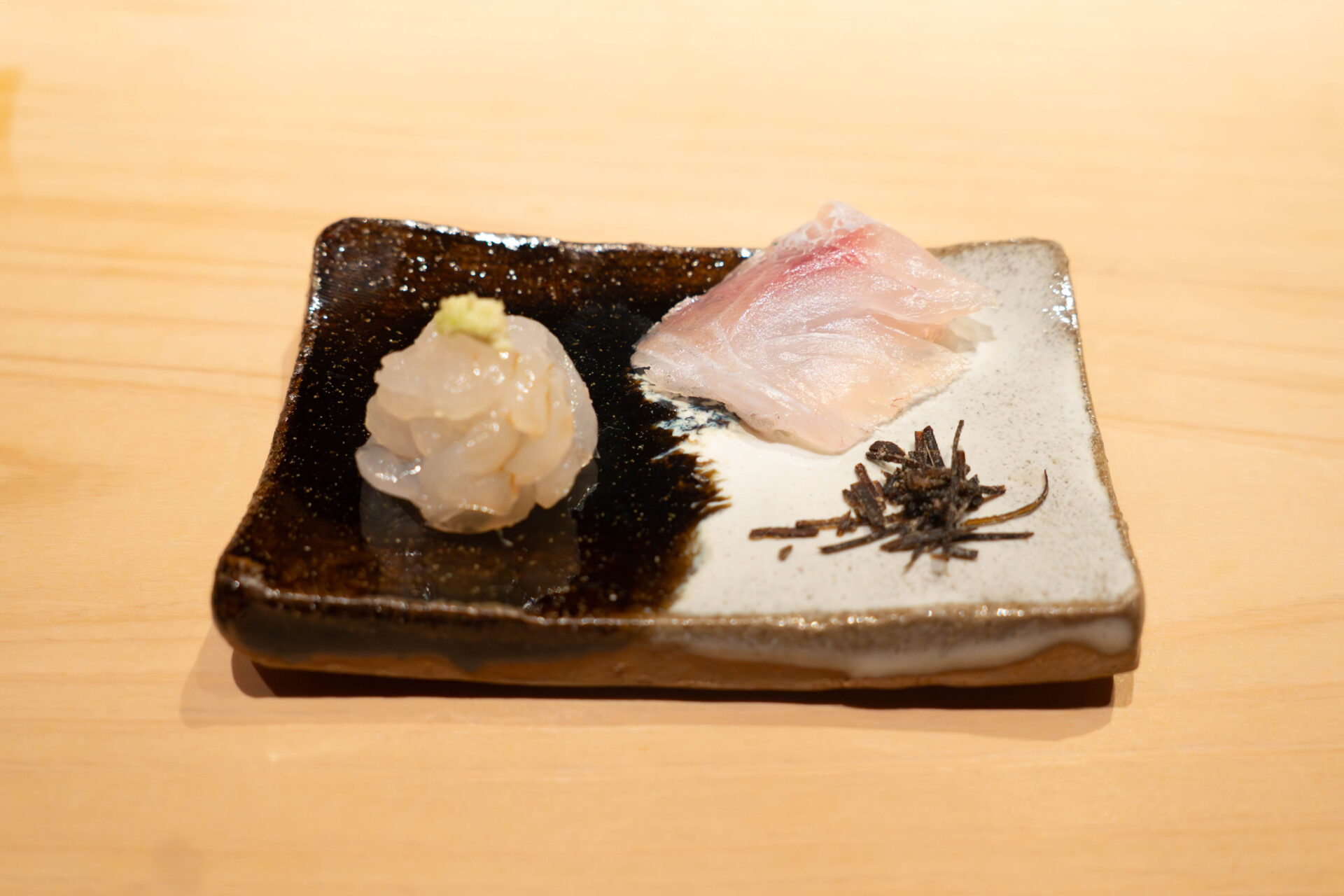
Bonito Two Ways
A single piece of bonito, prepared two different ways for comparison.
On the left: marinated bonito—moist, glossy, and accented with the brightness of karashi mustard.
On the right: straw-grilled bonito—its smoky aroma and gently sweet soy sauce with diced onion added layers of depth.
The dual preparation showcased both skill and playfulness, expressing multiple dimensions of one ingredient.
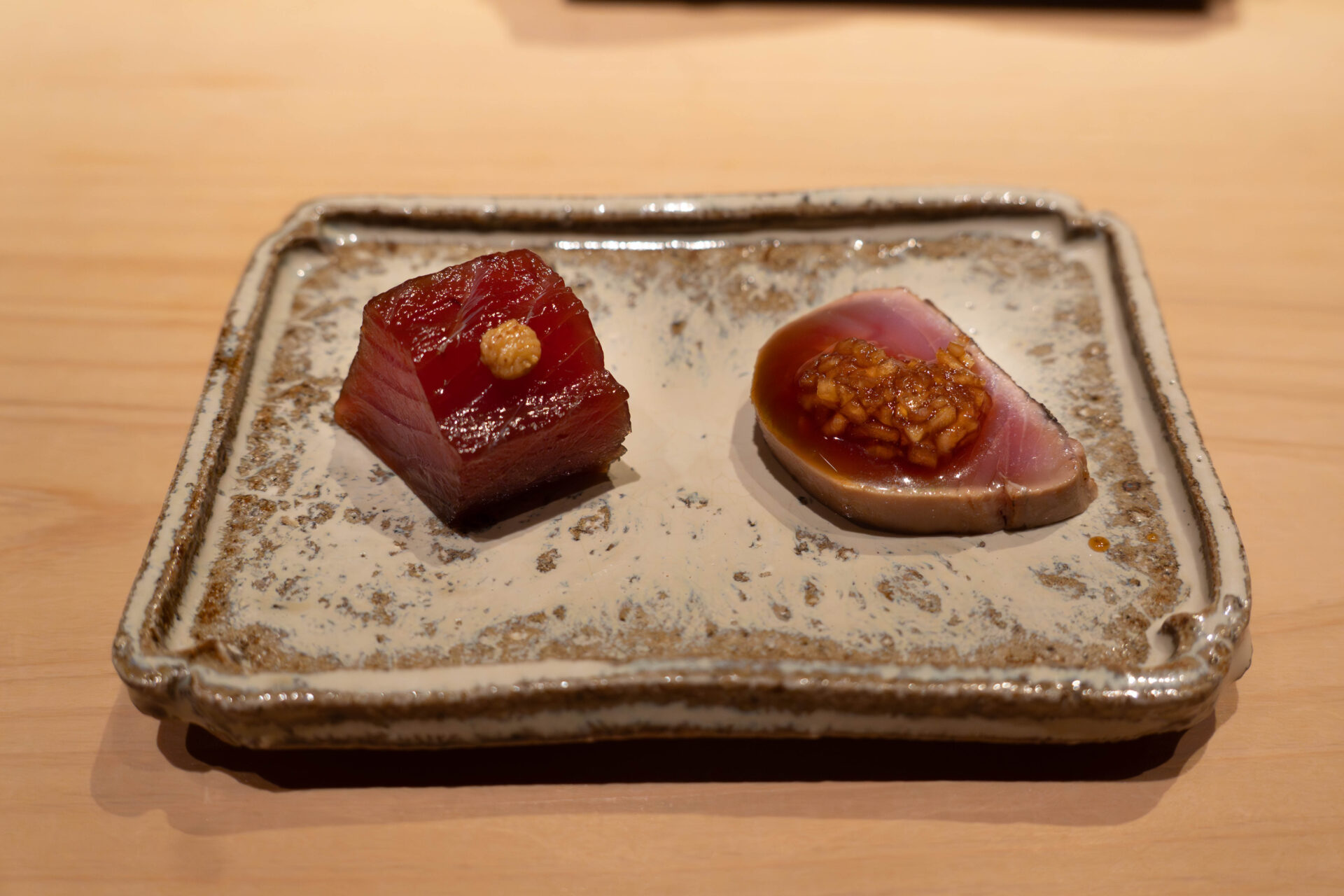
Sardine Roll and Grilled Pacific Saury
Next, a duo themed around blue-backed fish.
On the left: sardine roll wrapped in nori, where the fatty richness was balanced by refreshing herbs.
On the right: grilled Pacific saury, its crisp skin and melting fat capturing the strength of seasonal flavor.
Two expressions of blue fish, each using different methods to reveal their vivid individuality.
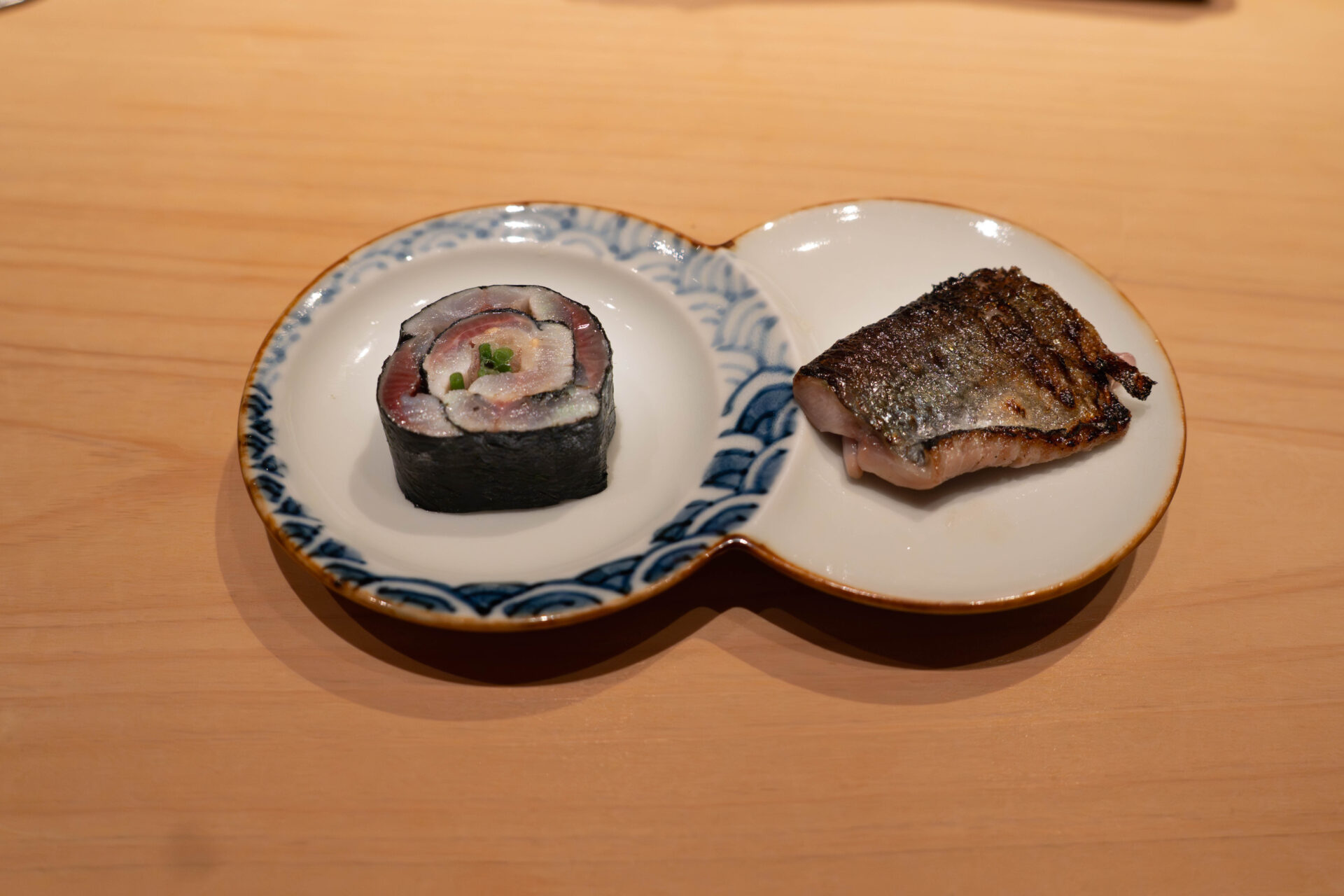
Grilled Fresh Anago (Conger Eel)
Presented next was grilled fresh anago.
The flesh was tender and cross-scored to allow even cooking—crispy on the outside, soft within. Each bite released the eel’s gentle sweetness and deep umami.
While simmered anago is typical in sushi, serving it grilled and fresh brought out the ingredient’s pure, unadorned flavor.
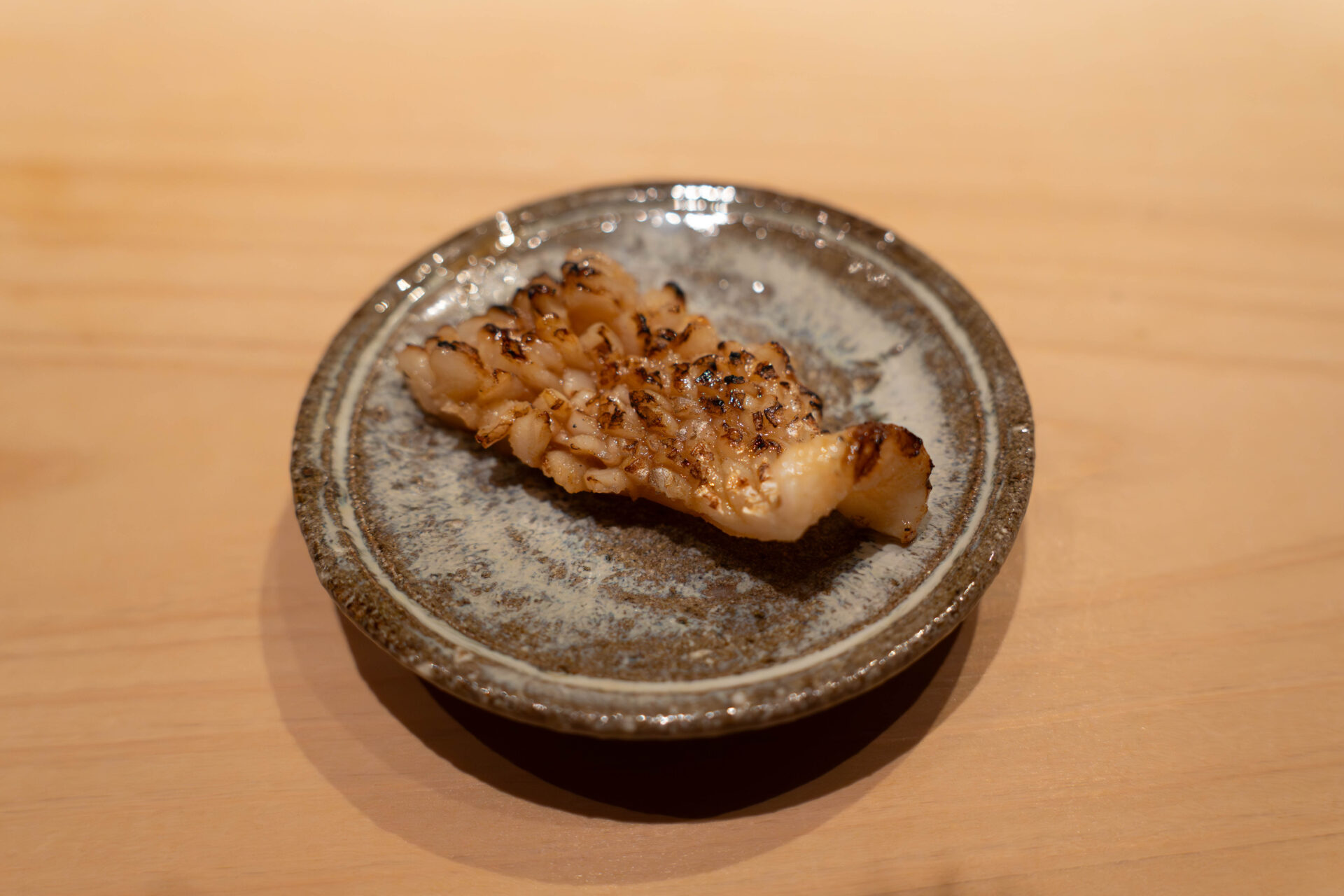
Simmered Anago Liver
Next came simmered anago liver.
Softly cooked, it gently crumbled on the tongue, releasing a rich umami and a faint bitterness. The sweet-savory broth wrapped the flavor warmly, inviting a sip of sake.
Paired beautifully with the earlier grilled anago, this dish deepened the appreciation for the same ingredient through contrast.
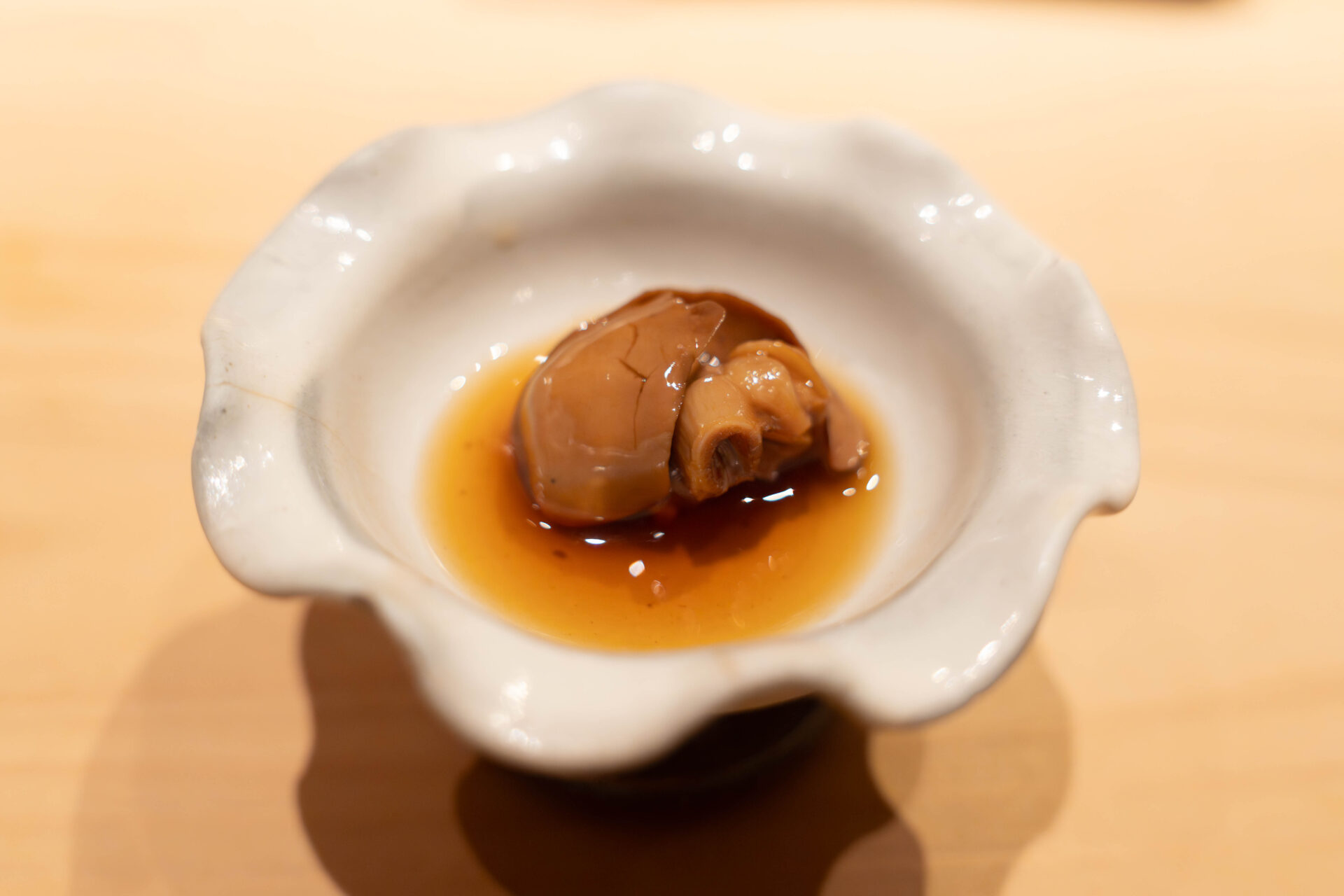
Mackerel Bozushi (Pressed Sushi)
A visually striking piece of mackerel bozushi appeared next.
Fatty, glistening mackerel was wrapped in kelp and paired with shari seasoned with akazu. A touch of green herbs at the center added brightness to the rich umami.
Each bite carried both weight and delicacy, blending tradition with the restaurant’s refined sensibility.
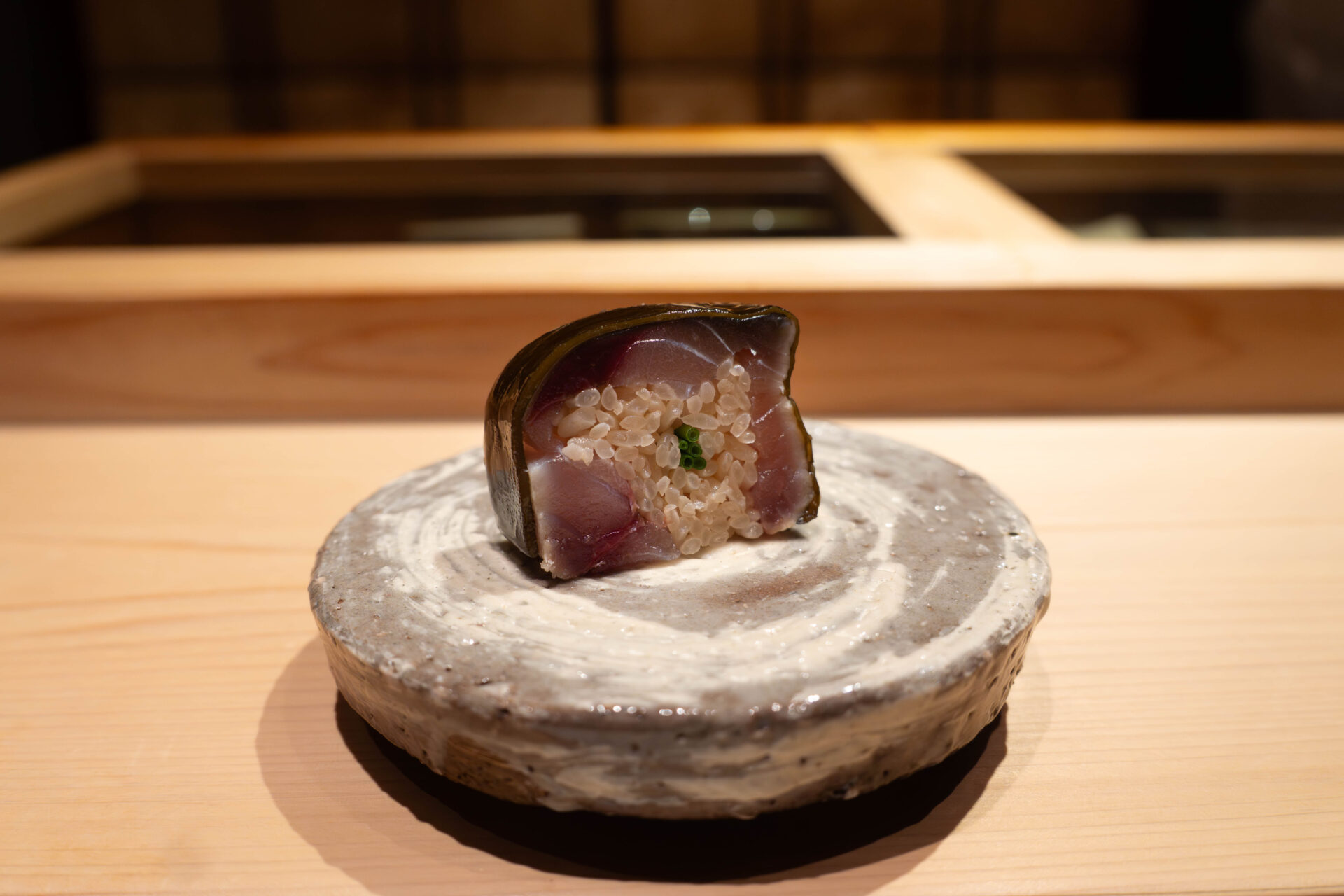
Shijimi Clam Broth
To reset the palate, a clear broth of shijimi clams was served.
The clean aroma and umami of the clams, refined with kombu and salt, created a gentle simplicity that nourished the body.
It served as a perfect transition—cleansing the senses before moving into the nigiri portion of the meal.
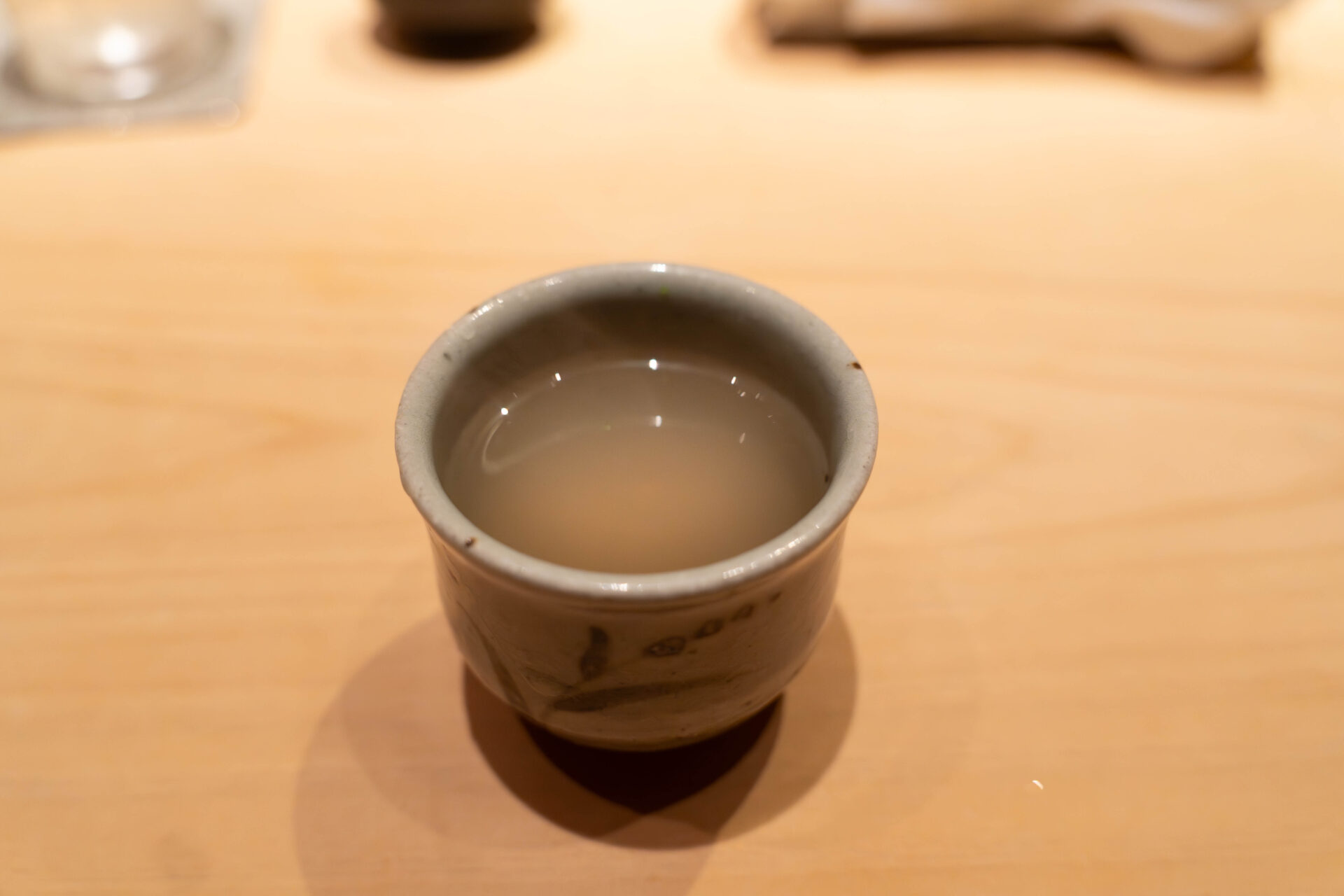
Kawahagi with Liver Sauce
Before the nigiri began, kawahagi (thread-sail filefish) dressed with its own liver sauce was served.
The mild flesh was enveloped in a rich, silky sauce, creating a beautiful balance of sweetness and depth. The liver’s umami enhanced the fish’s elegance, showcasing the artistry of sushi cuisine.
After finishing, wakame seaweed in the bowl allowed the remaining sauce to be enjoyed a second time—an example of the chef’s playfulness and precision.
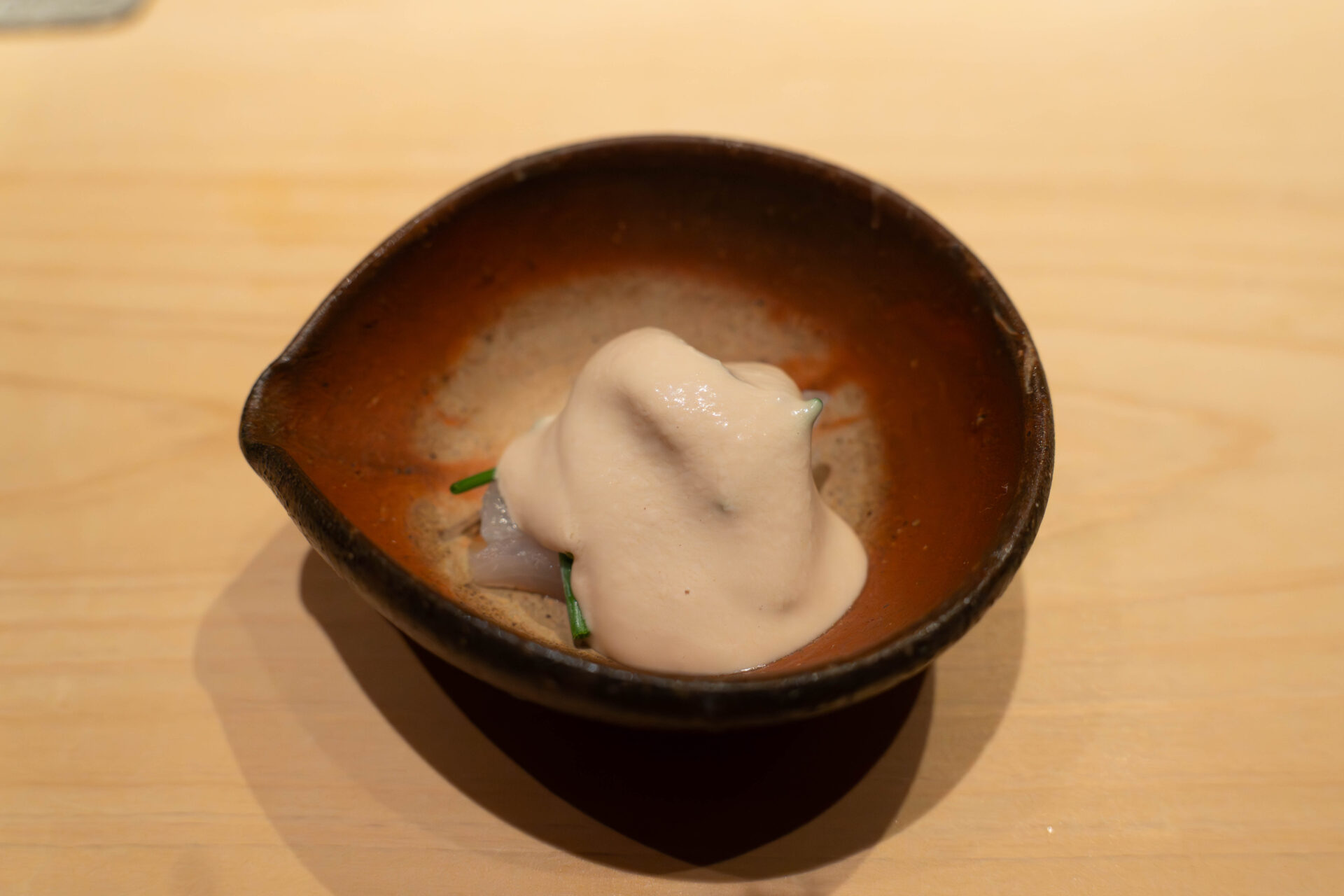
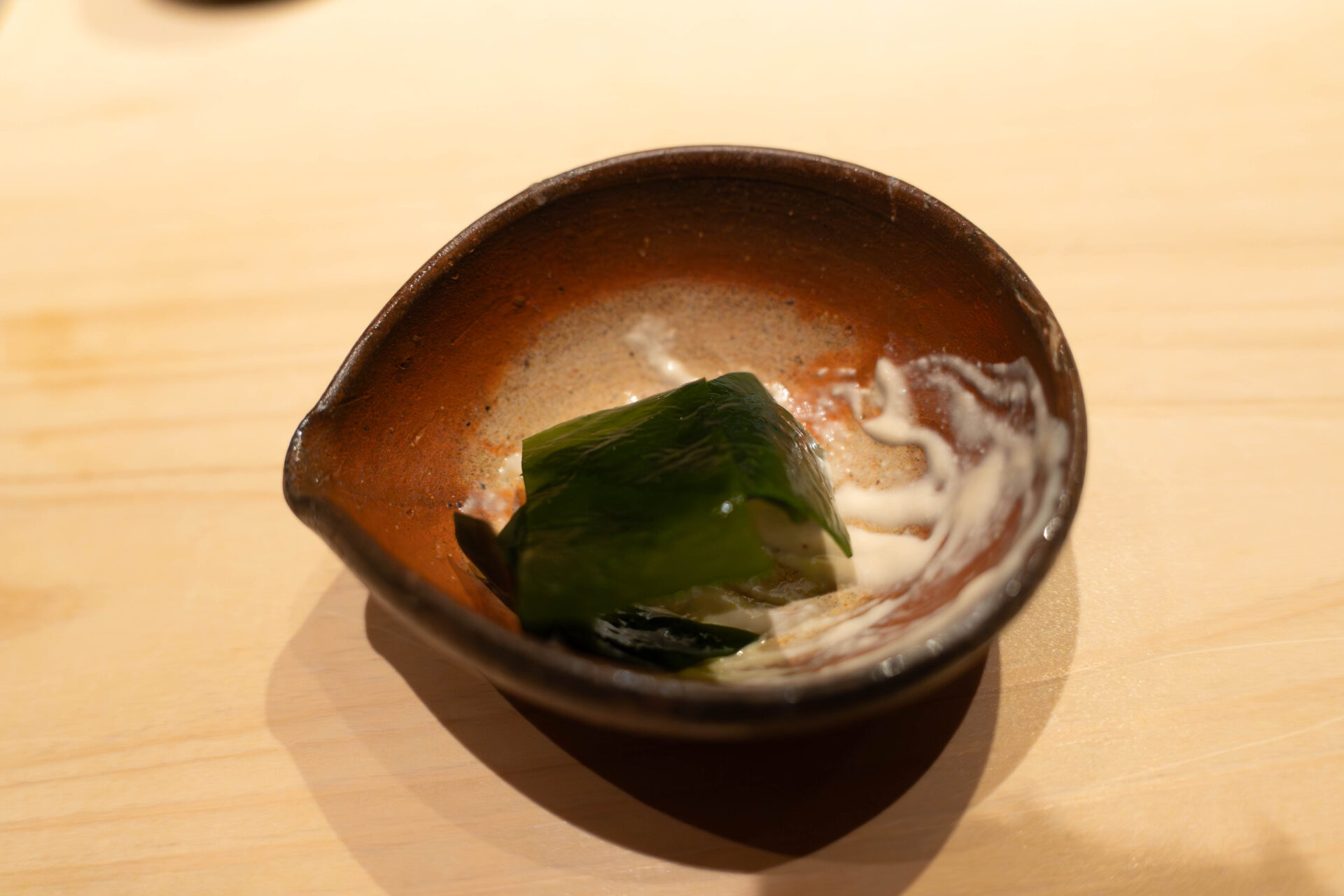
Yari-Ika (Spear Squid)
The first nigiri to mark the beginning of the sushi sequence was spear squid.
Finely scored, it offered both a clean bite and a gentle sweetness. The shari seasoned with red vinegar supported the squid’s delicacy, allowing the umami to bloom with each chew.
A pristine and refreshing start that elegantly signaled the beginning of the nigiri course.
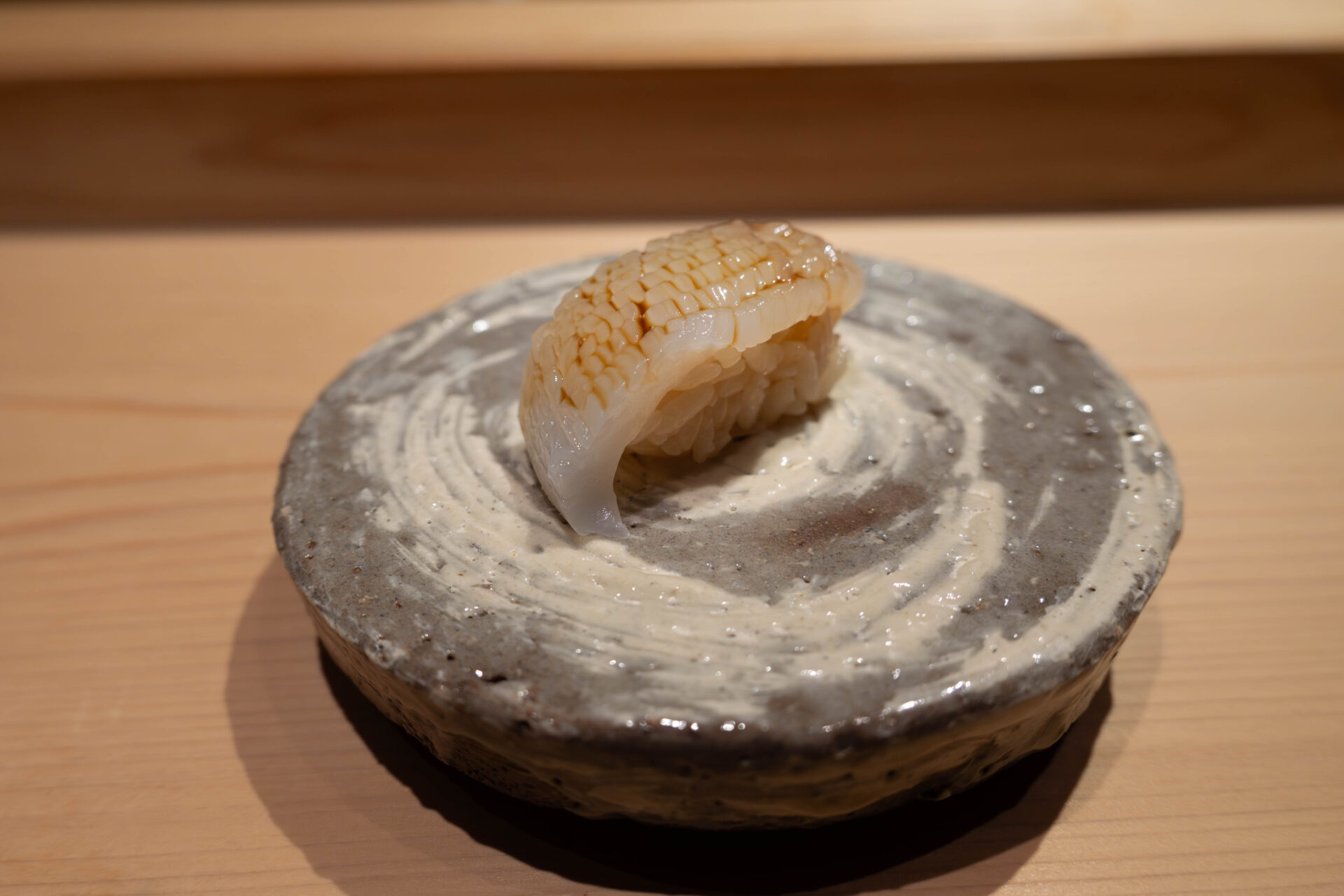
Madai (Sea Bream)
Next came sea bream nigiri.
The translucent flesh had a pleasant firmness, releasing refined sweetness as it was chewed. Light aging drew out its umami, while the red-vinegared rice absorbed the finish beautifully.
A deceptively simple piece that revealed the chef’s mastery through restraint.
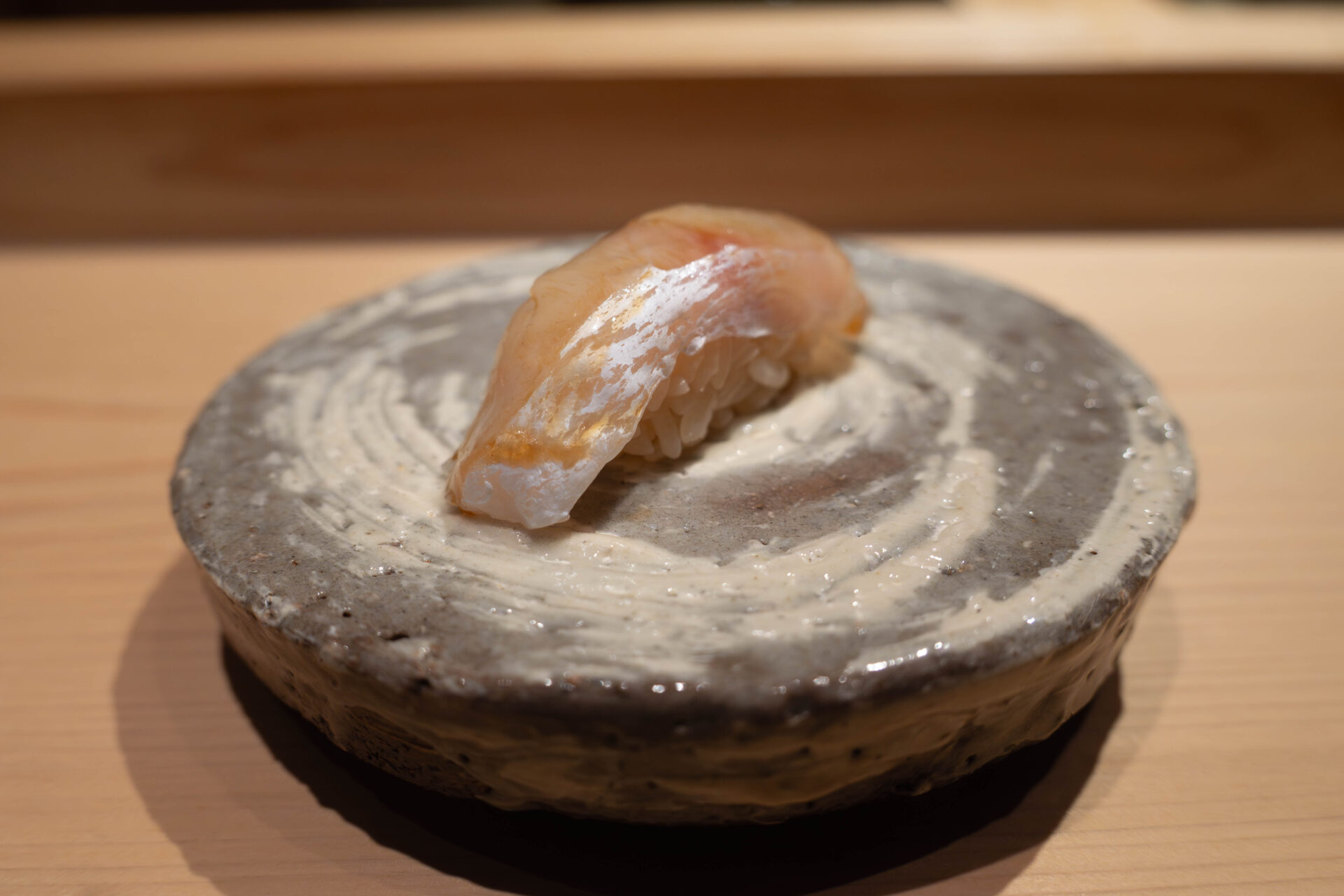
Shinko (Young Gizzard Shad) – Two Layers
An iconic Edomae-style nigiri, shinko was served next.
The delicate fish was layered twice to achieve the perfect balance of texture and presence. Its faint umami melted on the tongue as the red vinegar rice gently supported it.
A seasonal delicacy that perfectly captured a fleeting moment of summer.
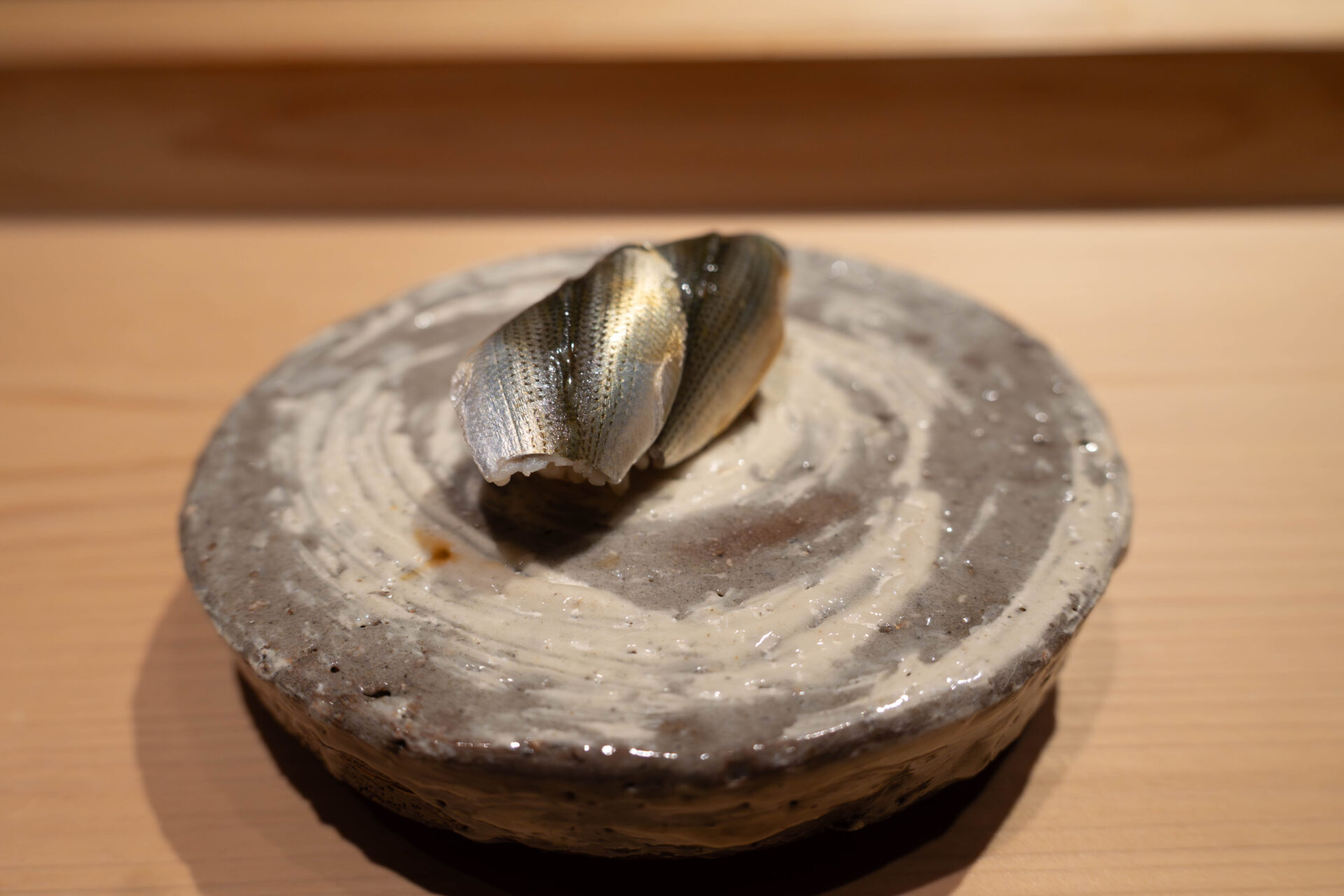
Maguro Akami Zuke (Marinated Lean Tuna)
The marinated lean tuna came from a single-line caught Canadian bluefin handled by Yamayuki.
Marination enhanced its clarity of flavor and silky texture, while the seasoned rice created perfect harmony in the mouth.
A clean, elegant expression that illuminated the middle of the course.
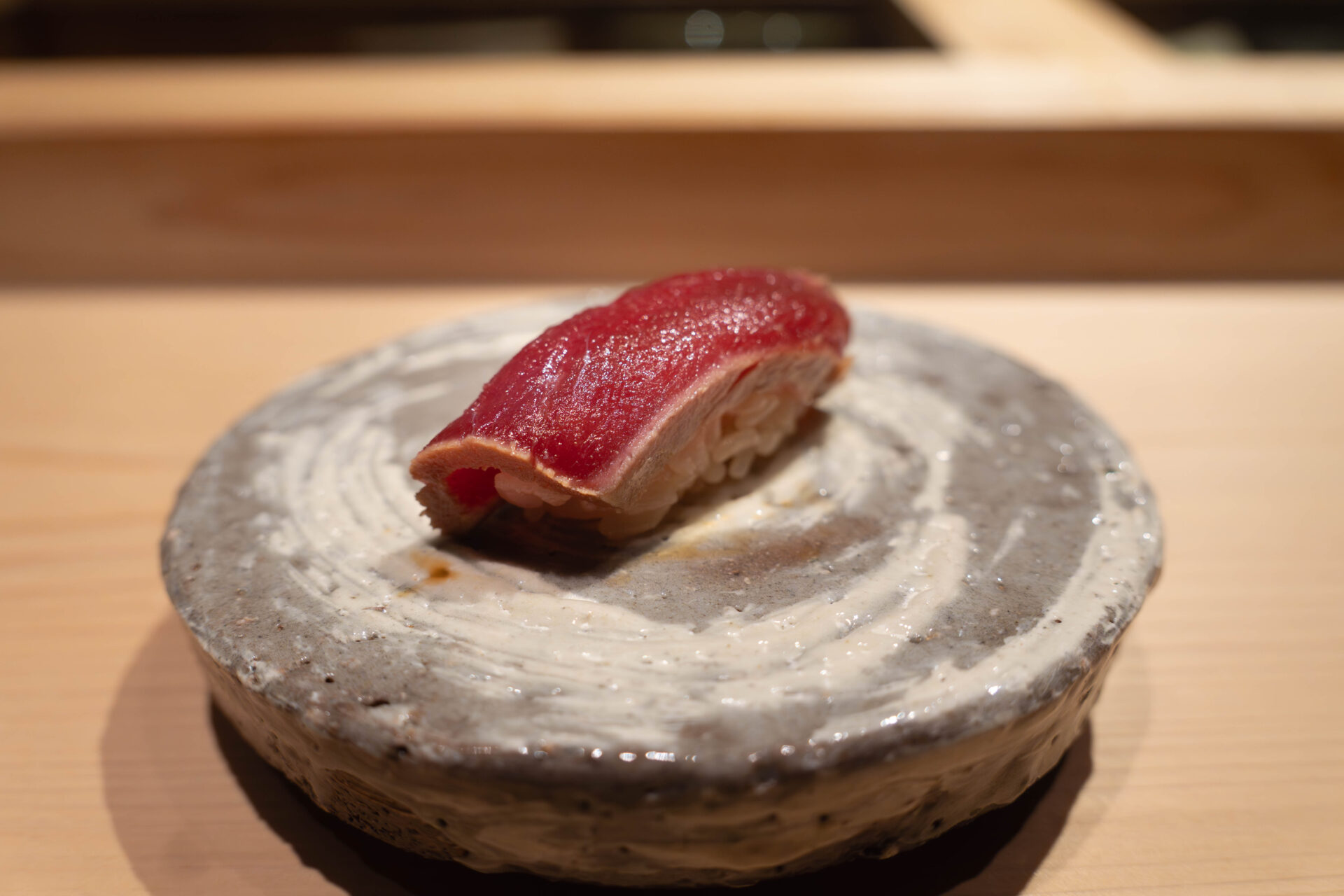
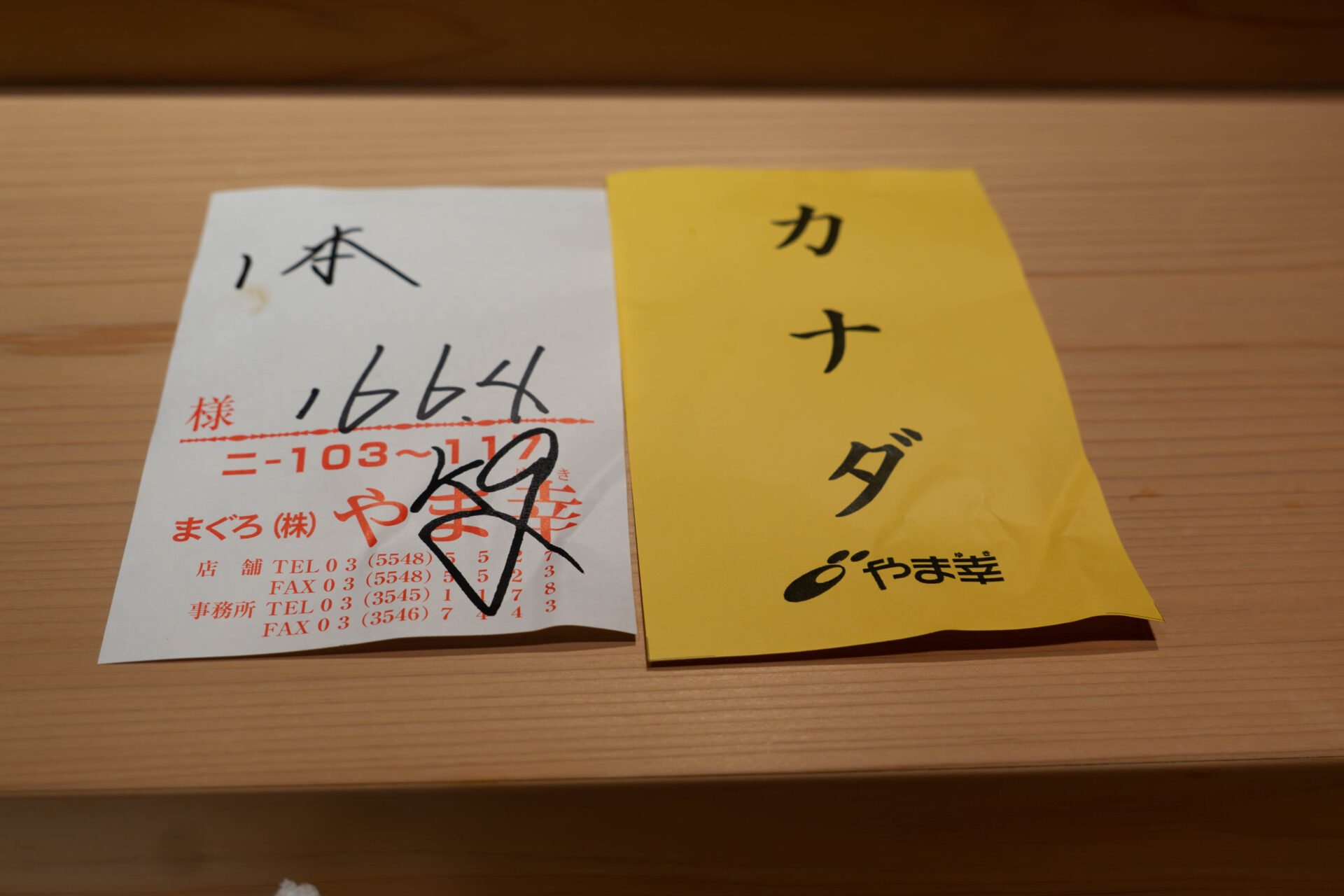
Otoro (Fatty Tuna)
The following piece was otoro, glistening with luscious fat.
It melted the moment it touched the tongue, releasing rich sweetness and depth. The red-vinegared rice grounded its intensity, resulting in an indulgent yet refined balance.
Flowing naturally from the akami, it provided a delightful crescendo to the tuna sequence.
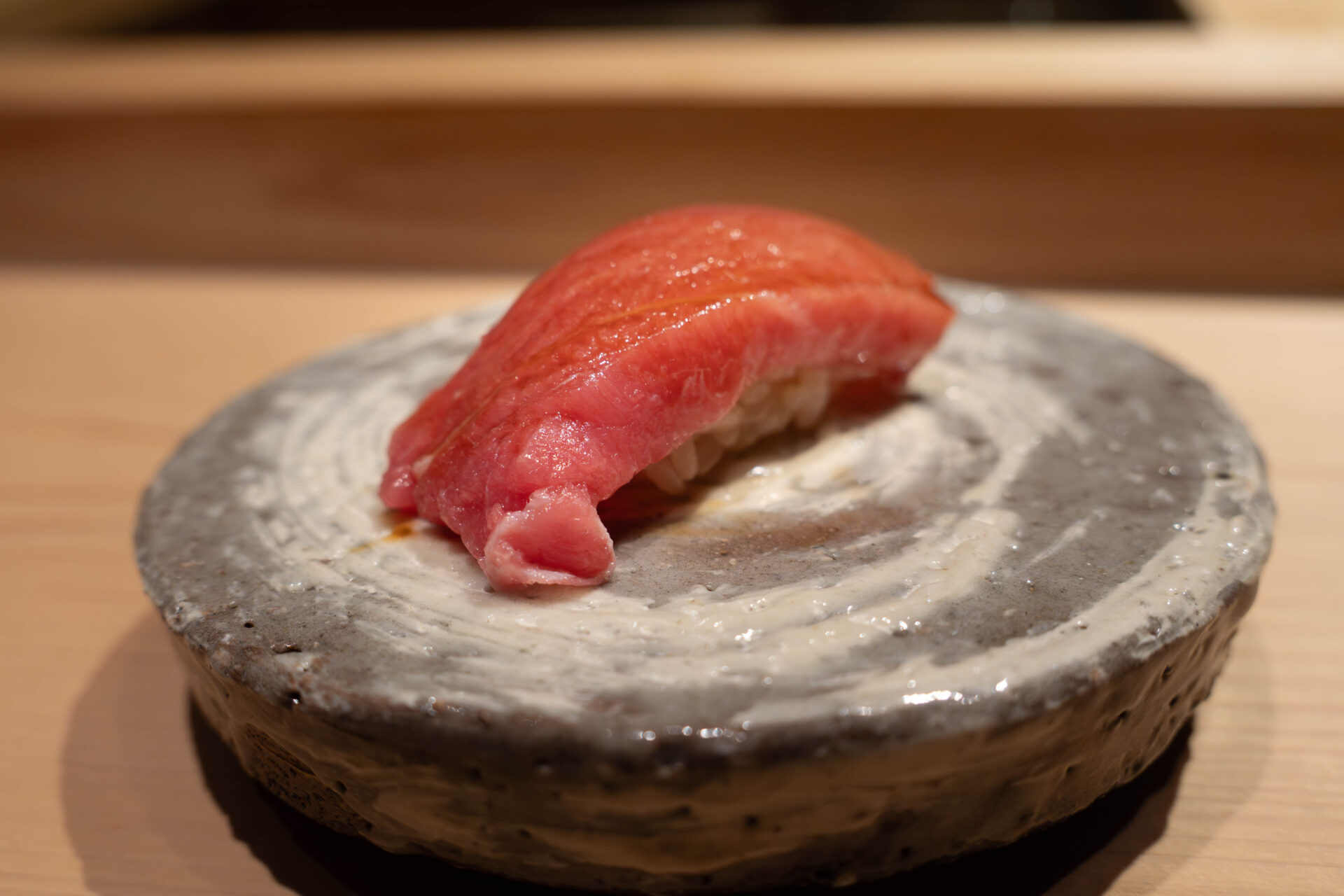
Aji from Nagasaki (Horse Mackerel)
Next came horse mackerel from Nagasaki.
Its fresh, glistening flesh carried rich fat, releasing savory flavor with each bite. The garnish of herbs added fragrance and a refreshing lift.
A satisfying balance of strength and brightness, highlighting superb freshness.
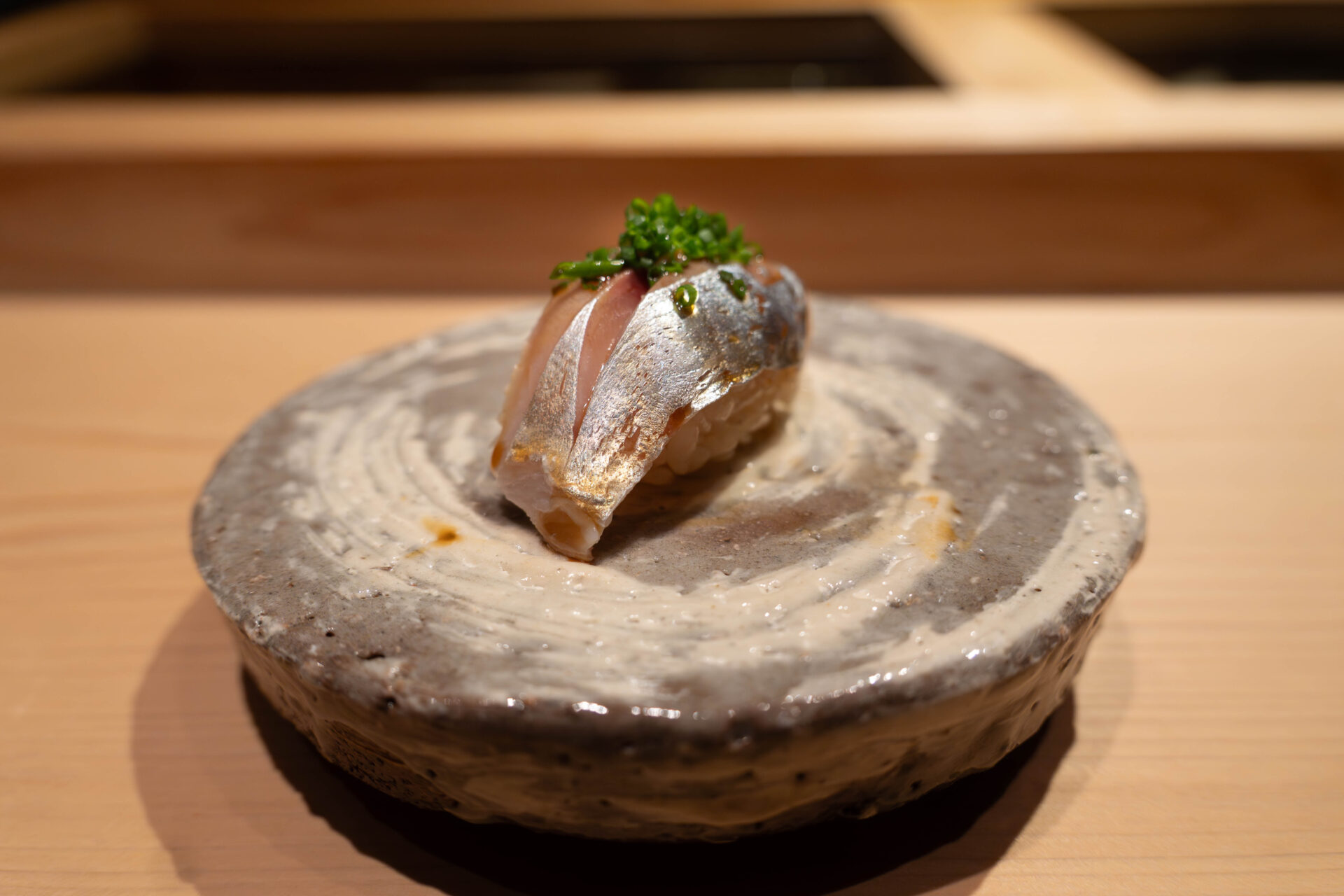
Ikura (Salmon Roe)
A vivid bowl of glistening salmon roe followed.
Each pearl burst on the tongue, releasing gentle salinity and oceanic umami. The red-vinegared rice beneath bound the flavors in harmony.
Its jewel-like appearance and deep savor added a brilliant highlight to the flow of the course.
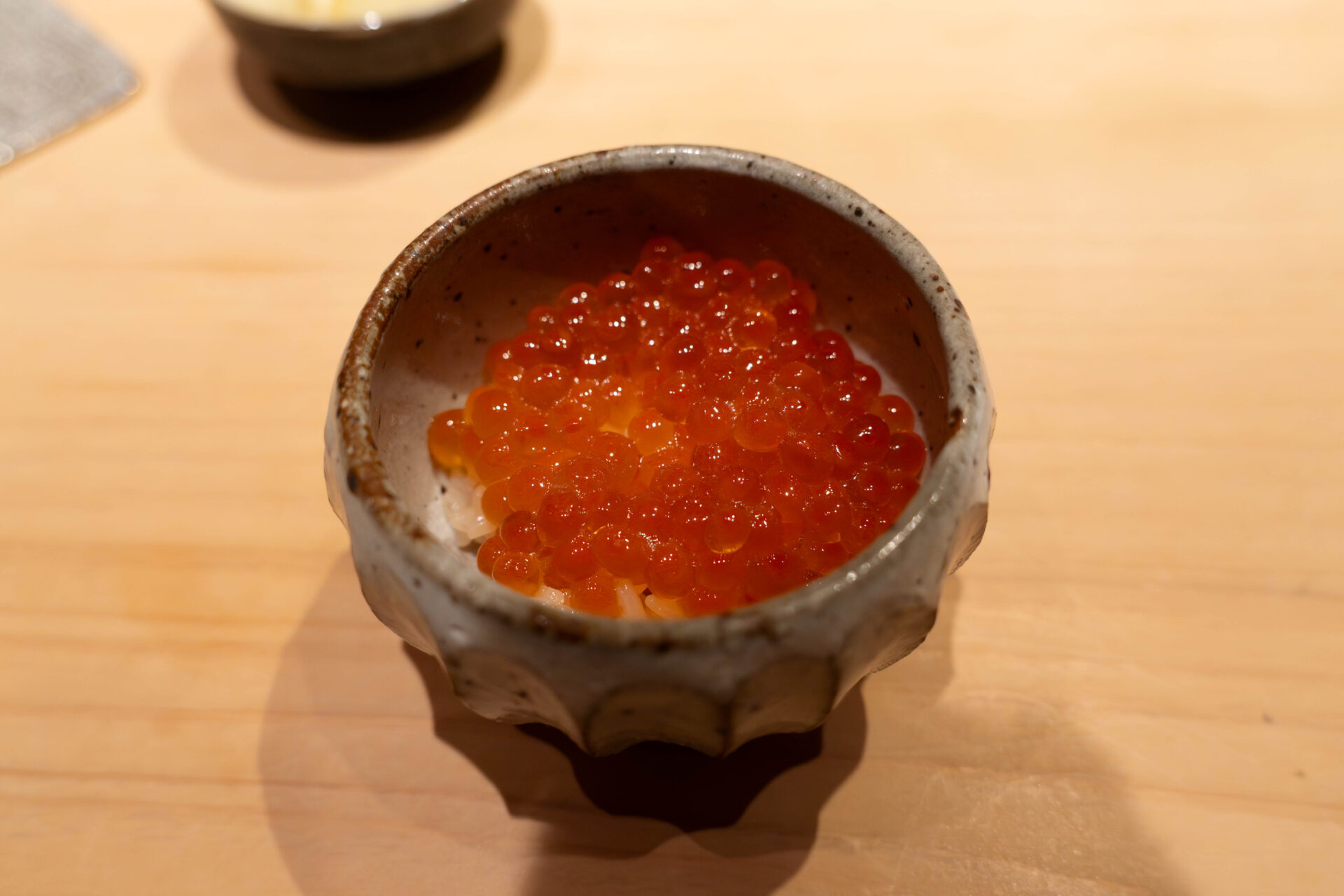
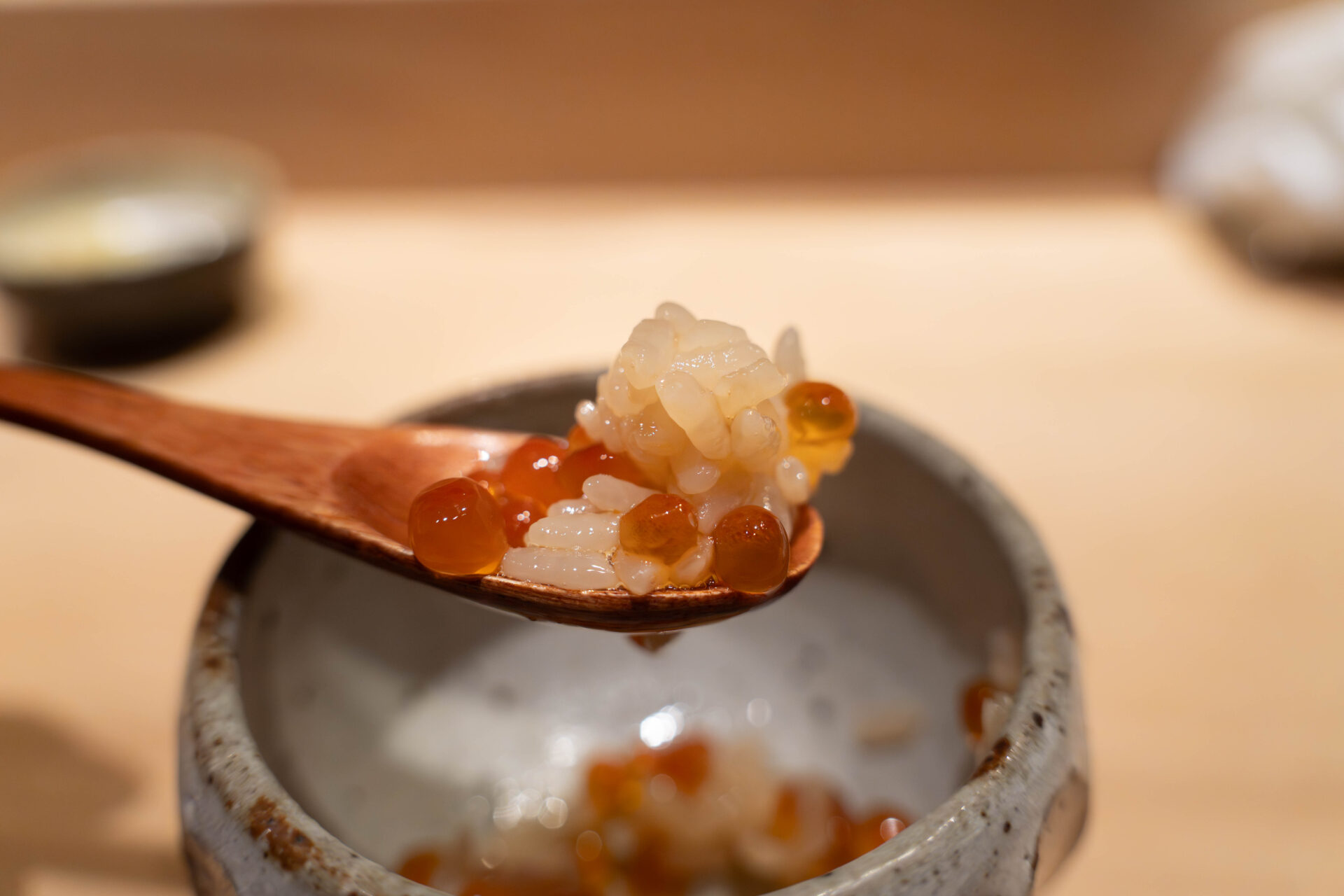
Red Uni from Fukuoka
Then came red sea urchin from Fukuoka.
Its vivid orange flesh melted instantly, filling the mouth with luxurious sweetness and the scent of the sea. The shari’s gentle acidity tightened the flavor beautifully.
A lavish expression of local bounty from Fukuoka’s coastal waters.
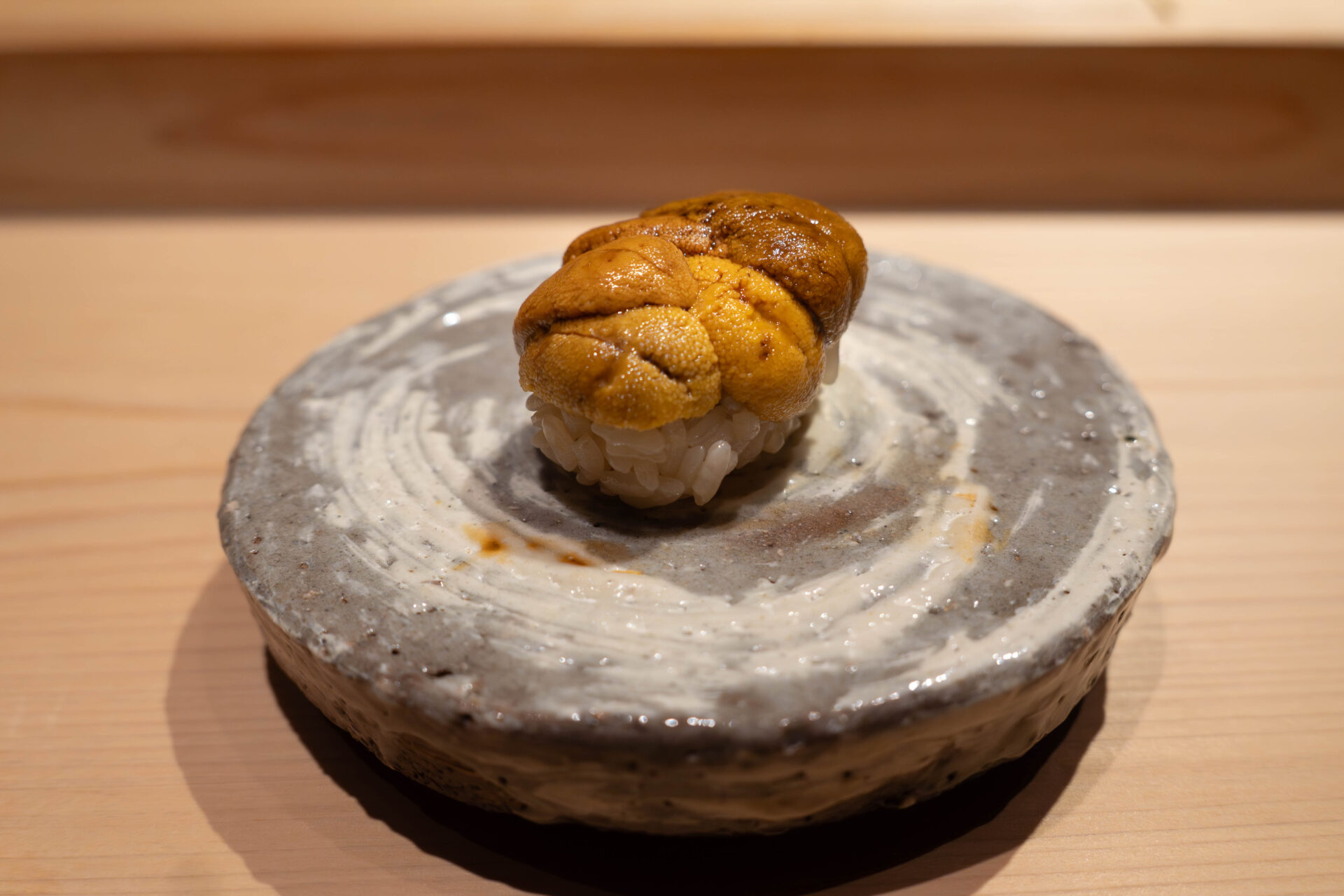
Hokkigai (Surf Clam)
Next, aburi-grilled hokkigai.
Its supple texture released a mild sweetness and the characteristic flavor of shellfish. The light sear added aroma and warmth, deepening its dimension with the red-vinegared rice.
Strong yet graceful, it served as a dignified conclusion to the nigiri sequence.
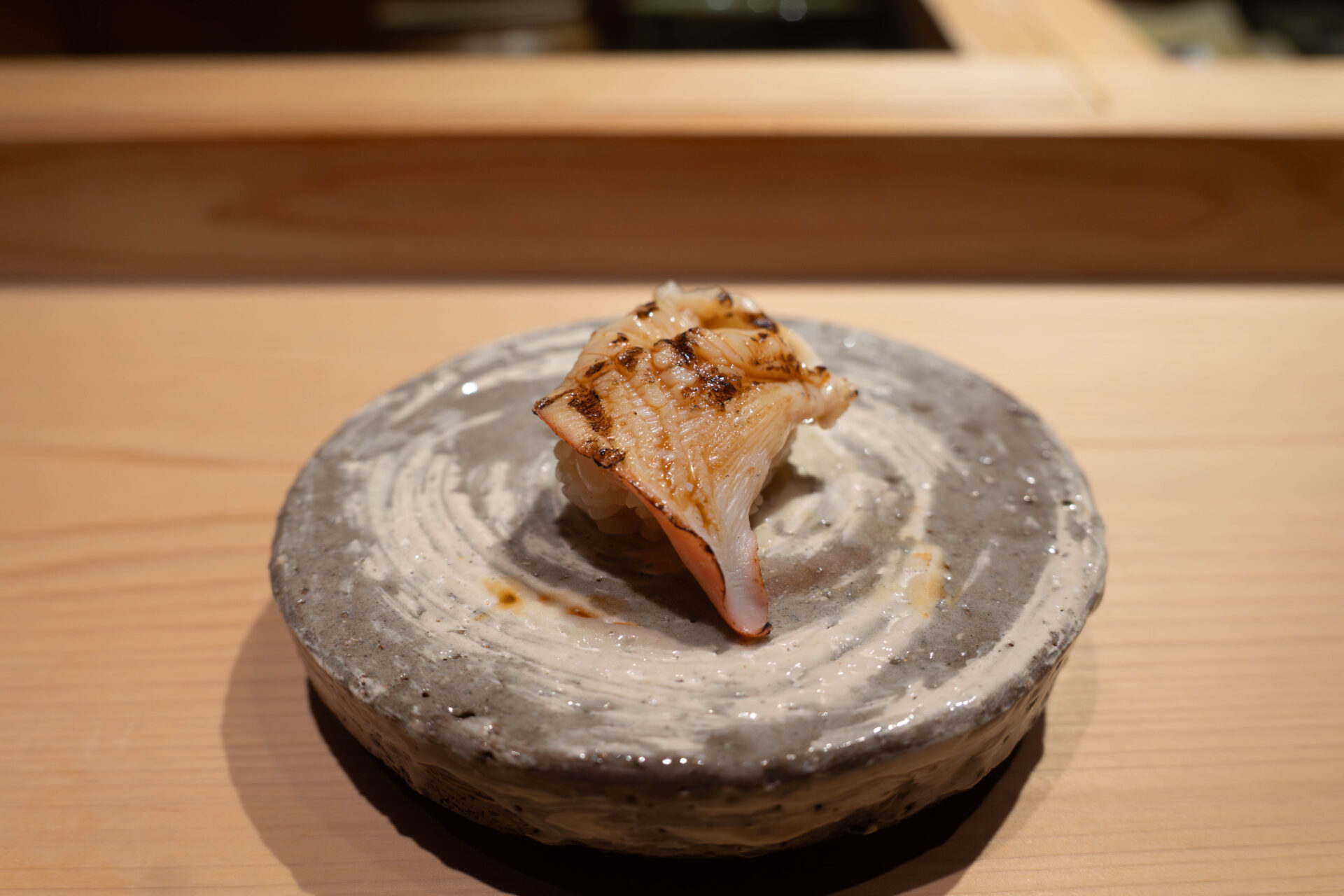
Kuruma Ebi (Tiger Prawn)
A brilliant red-and-white tiger prawn followed.
Firm and juicy, its sweetness deepened with each bite. A hint of char from the grill added aroma, finishing with a clean aftertaste.
Visually striking and celebratory, it heightened the final stages of the course.
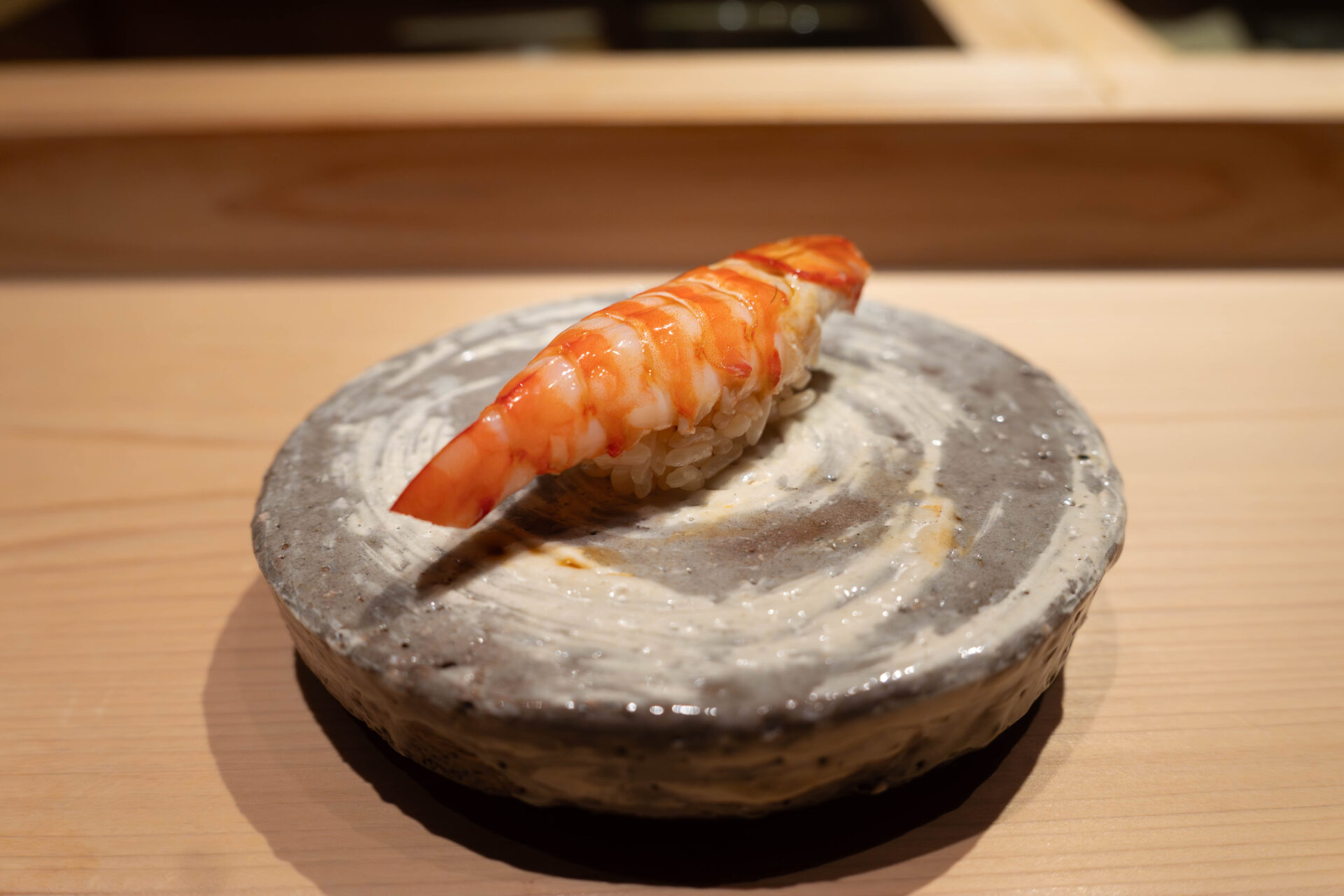
Hamaguri (Clam)
Plump simmered clam, tender and full-bodied.
Its natural umami and gentle sweetness were harmonized by nikiri soy glaze, creating a deeply satisfying flavor that lingered on the palate.
A substantial and elegant piece, leaving a strong impression as the course drew to a close.
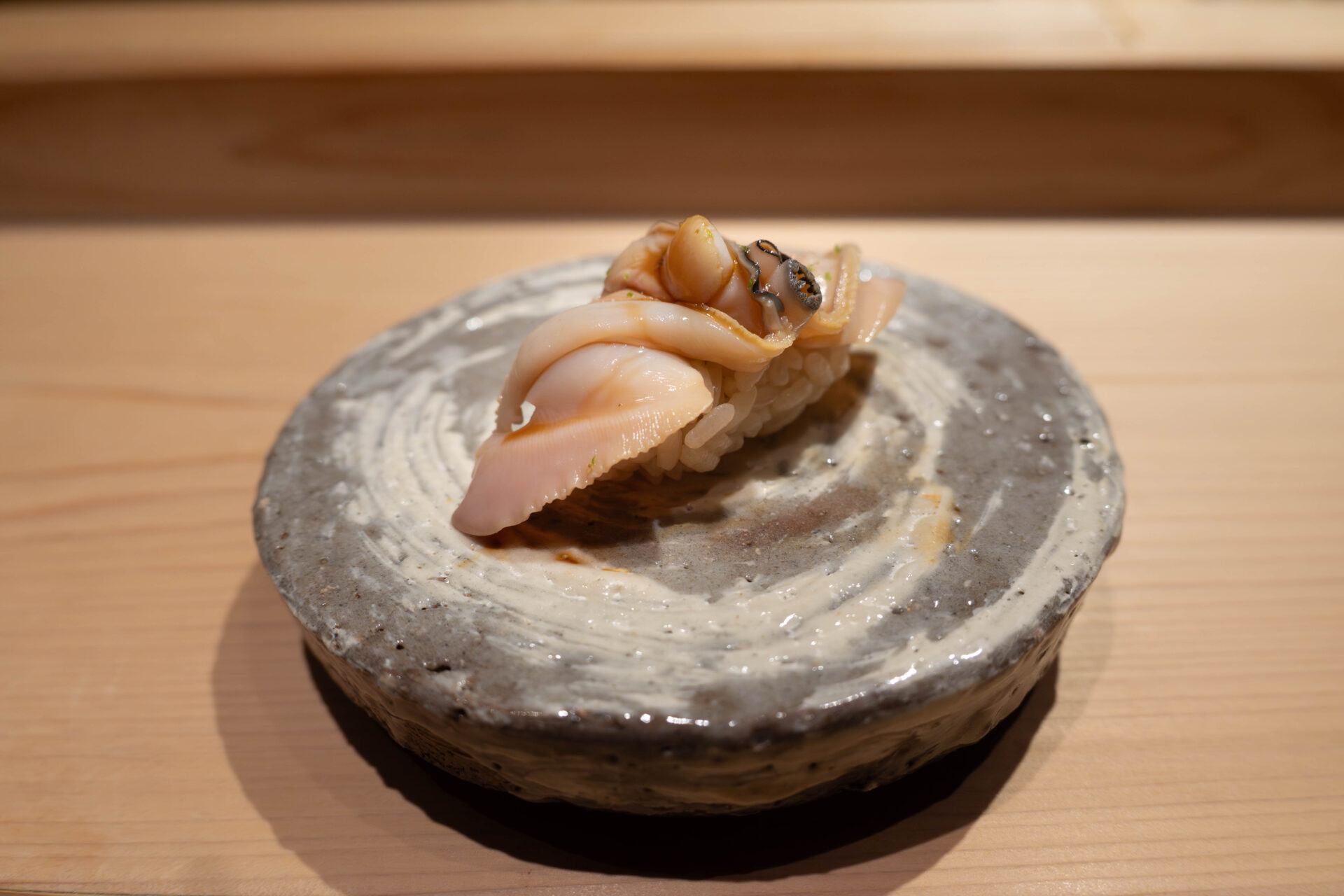
Anago (Sea Eel)
The final nigiri featured soft-simmered anago, lightly grilled and glazed with sweet tsume sauce.
The tender flesh melted effortlessly, leaving a lingering sweetness.
An exquisite, serene conclusion to the sushi sequence.
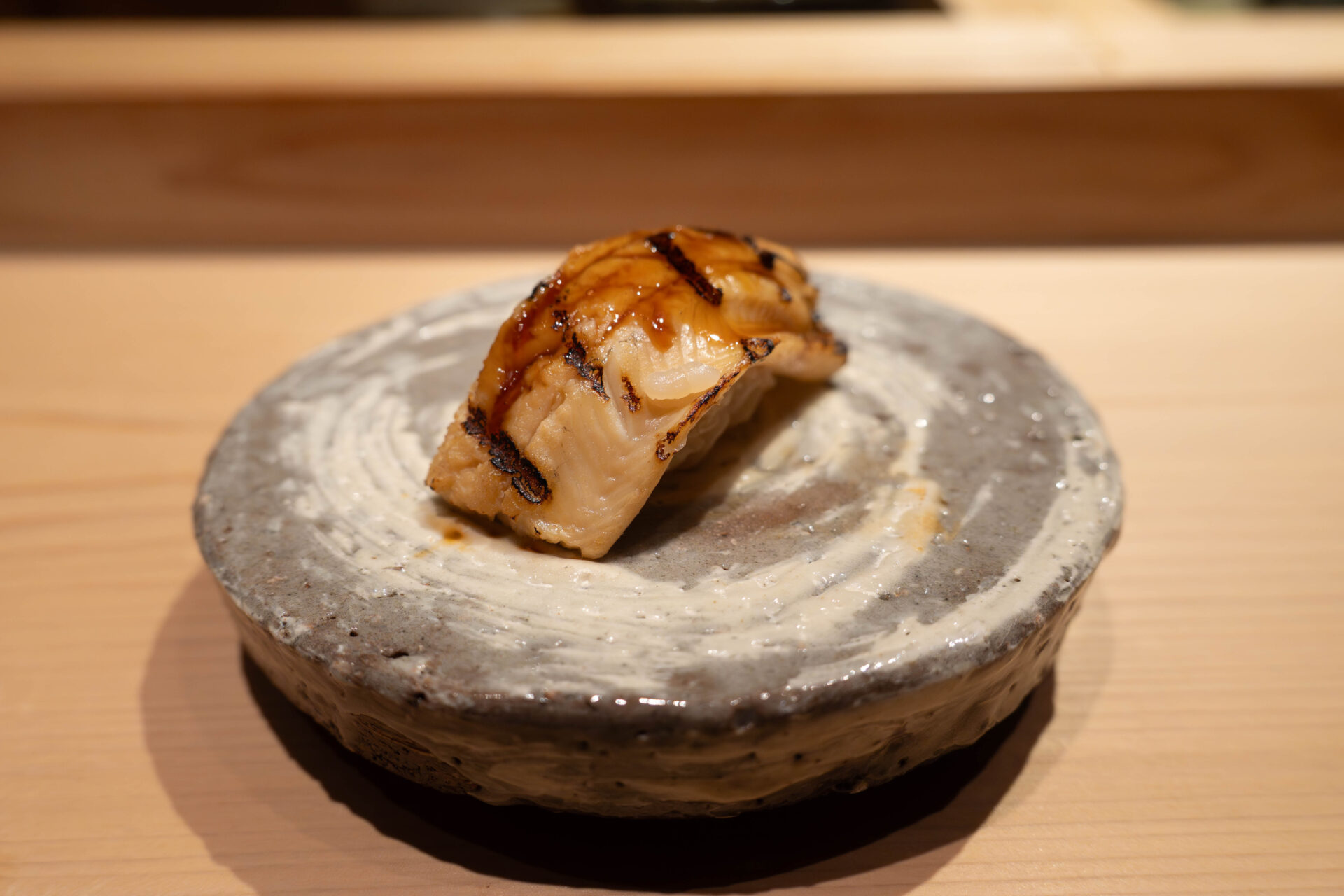
Miso Soup with Fish Bones
To close the course, miso soup made from fish bones.
Local Fukuoka kawatake (river algae) added aroma and depth.
A heartwarming bowl that gently embraced the lingering flavors of the meal.
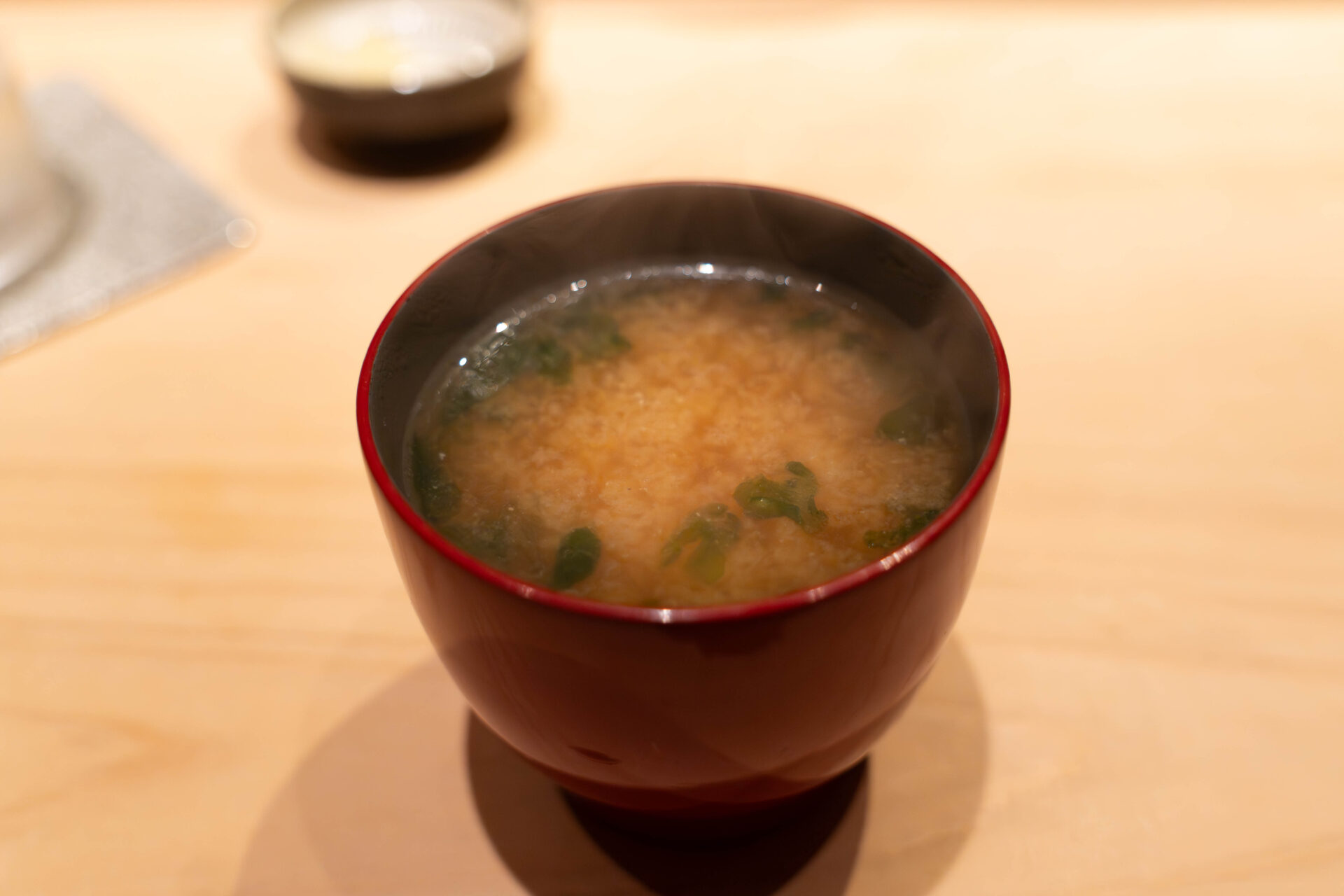
Kanpyo Roll
The classic Edomae kanpyo roll closed the main meal.
Sweet-savory simmered gourd harmonized beautifully with rice and nori.
Simple yet deeply comforting, it left a lingering sense of satisfaction.
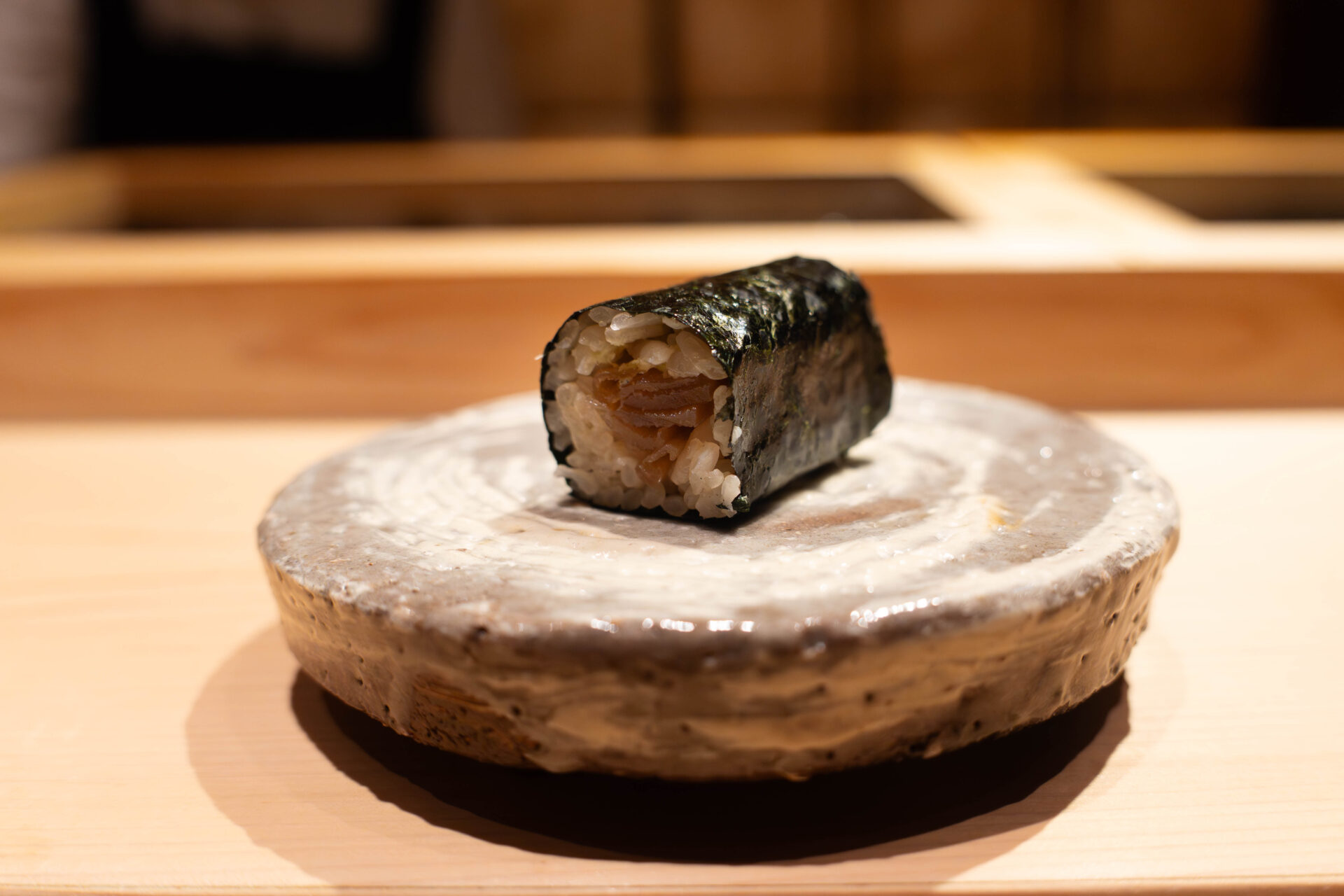
Additional Nigiri: Sardine
For an additional piece, sardine was chosen.
Richly fatty yet perfectly balanced, it offered power and depth.
A bold encore that reignited the course’s energy.
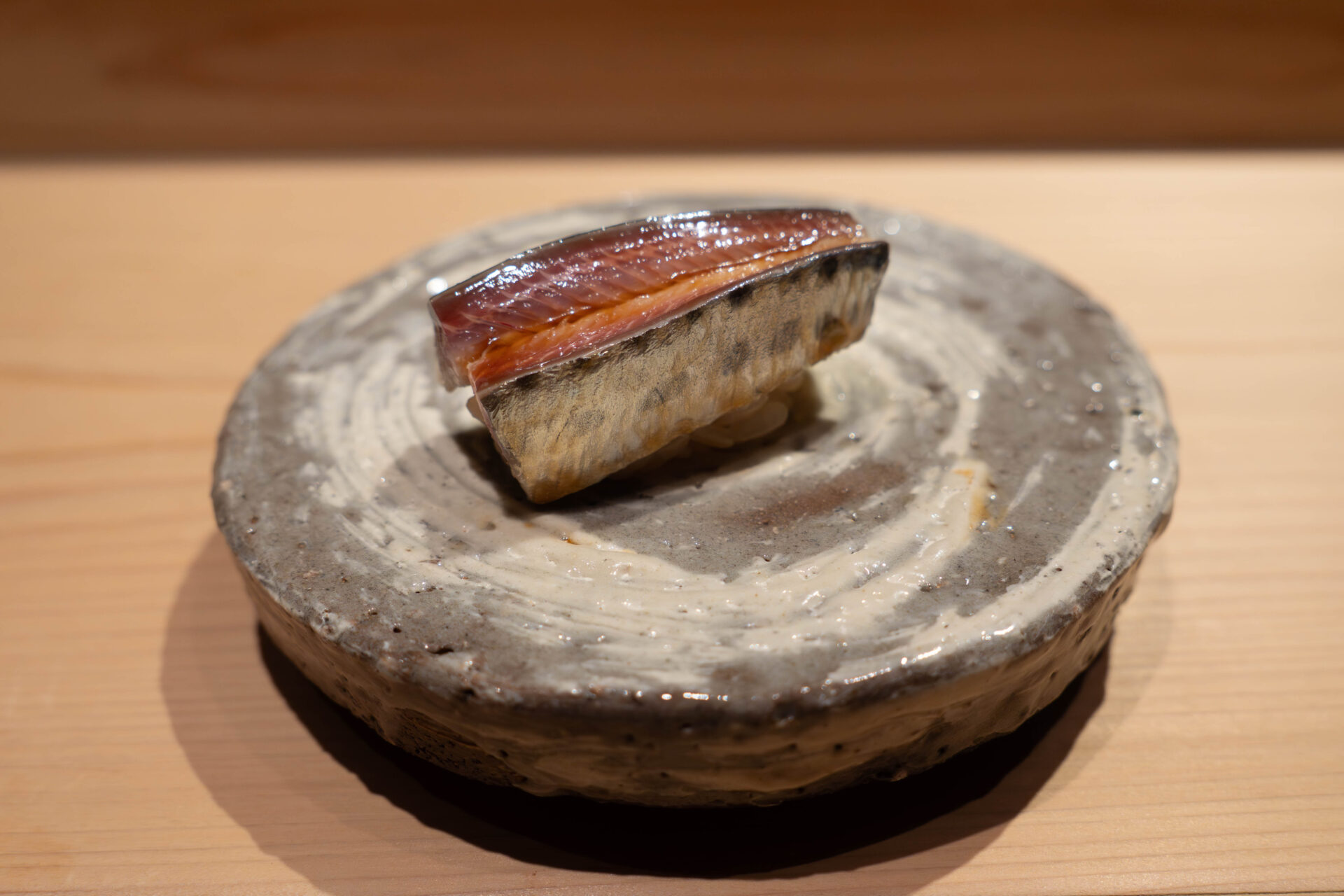
Additional Nigiri: Seared Akamutsu (Blackthroat Seaperch)
Another encore featured lightly seared akamutsu.
The gentle heat released its luxurious fat and aroma, creating an indulgent, resonant flavor.
A perfect finale, both powerful and elegant.
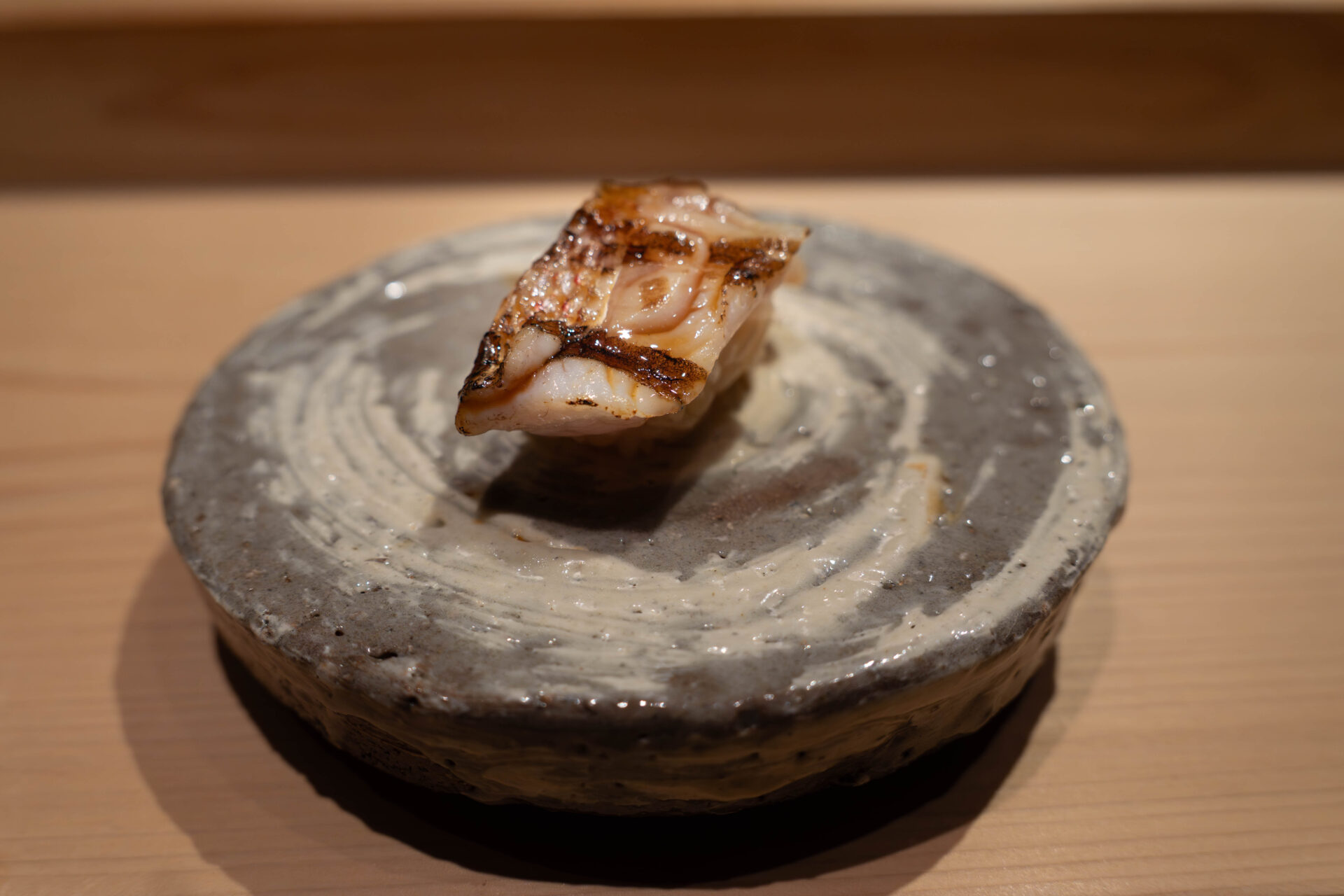
Final Bite: Okra and Plum Nori Roll
The closing roll combined okra and plum paste.
The tartness of plum and crisp texture of okra refreshed the palate, leaving a clean finish.
A perfect final touch—absolutely worth ordering as an extra.
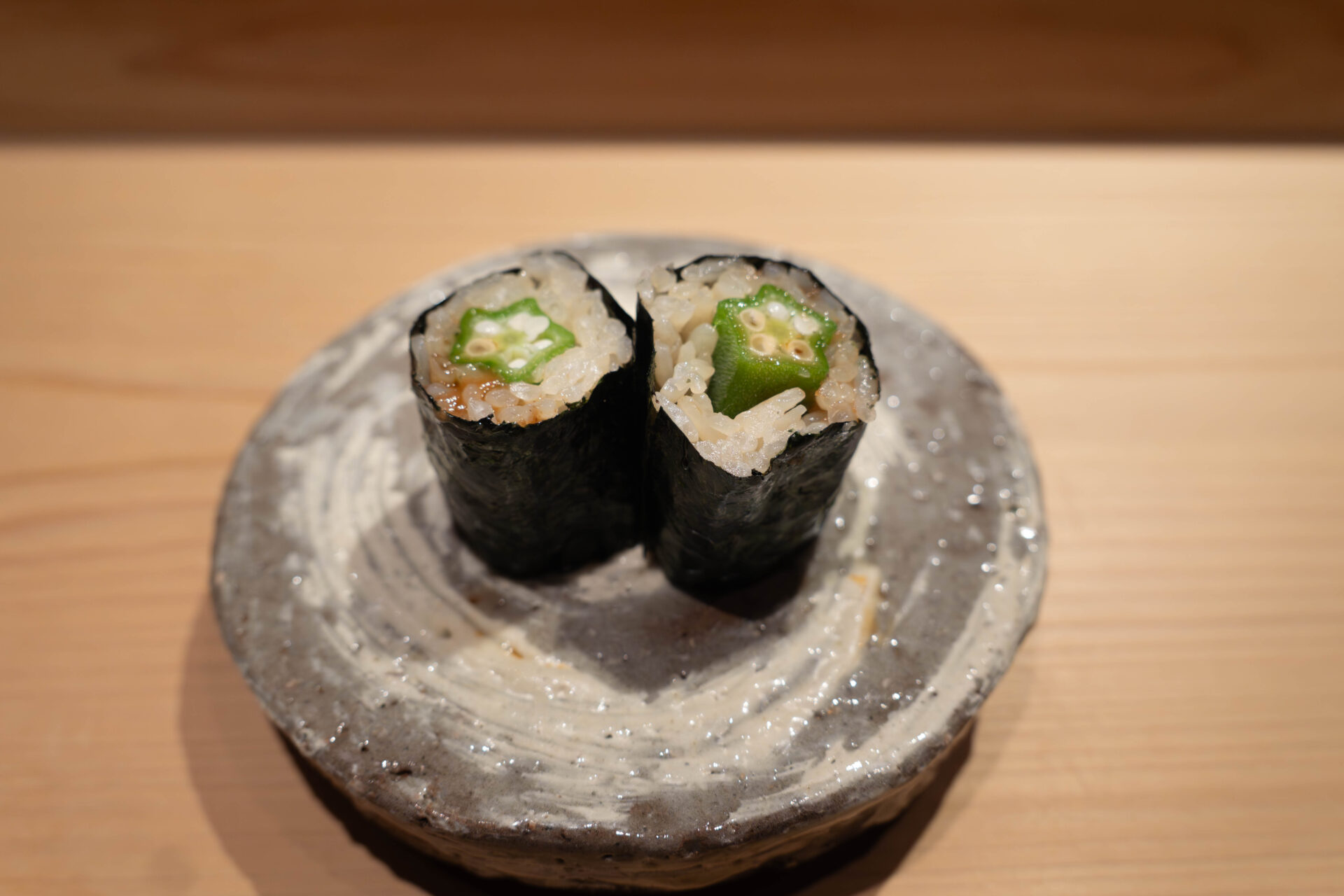
Tamagoyaki (Sweet Egg Omelet)
To conclude, a soft, sweet tamagoyaki reminiscent of castella cake.
Its gentle sweetness and fluffy texture brought warmth and closure.
A tender, nostalgic finale that left a lasting impression.
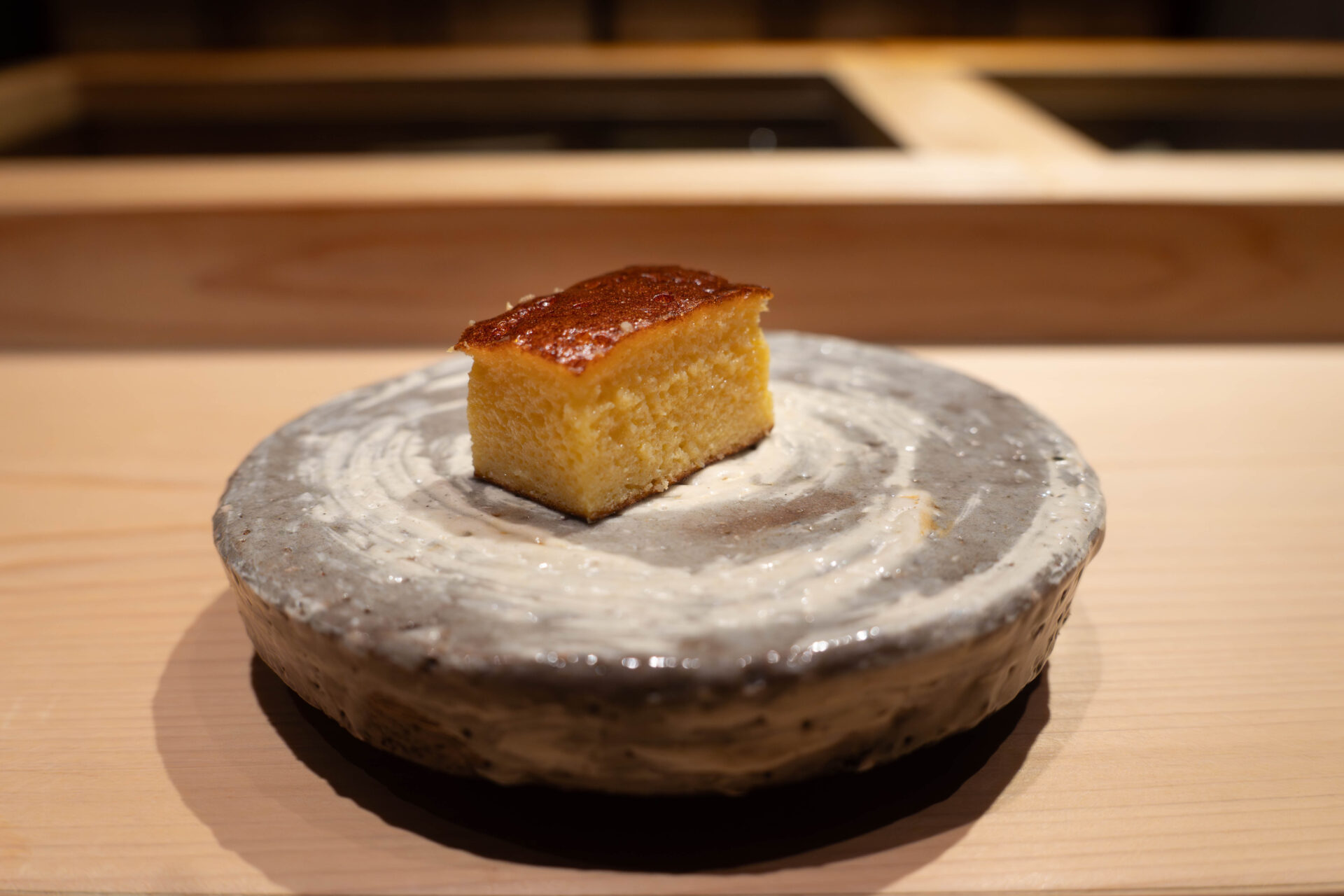
Dessert & Finale
Tea and Sweet
The meal ended with a vivid green tea whose fresh aroma enhanced the aftertaste.
Alongside it came a dumpling made with the same tea leaves served earlier—its tender texture, gentle bitterness, and subtle sweetness perfectly encapsulated the season’s grace.
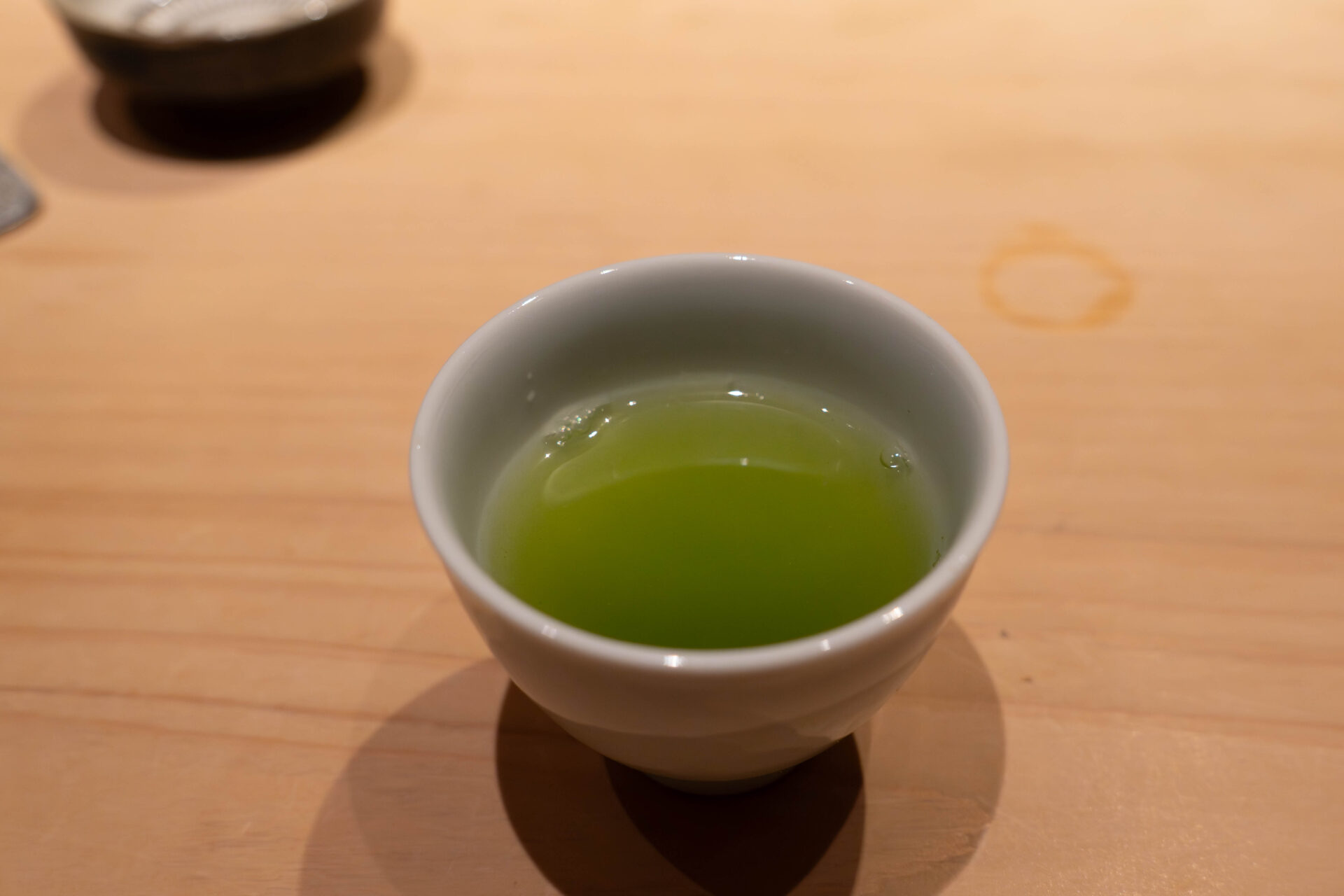
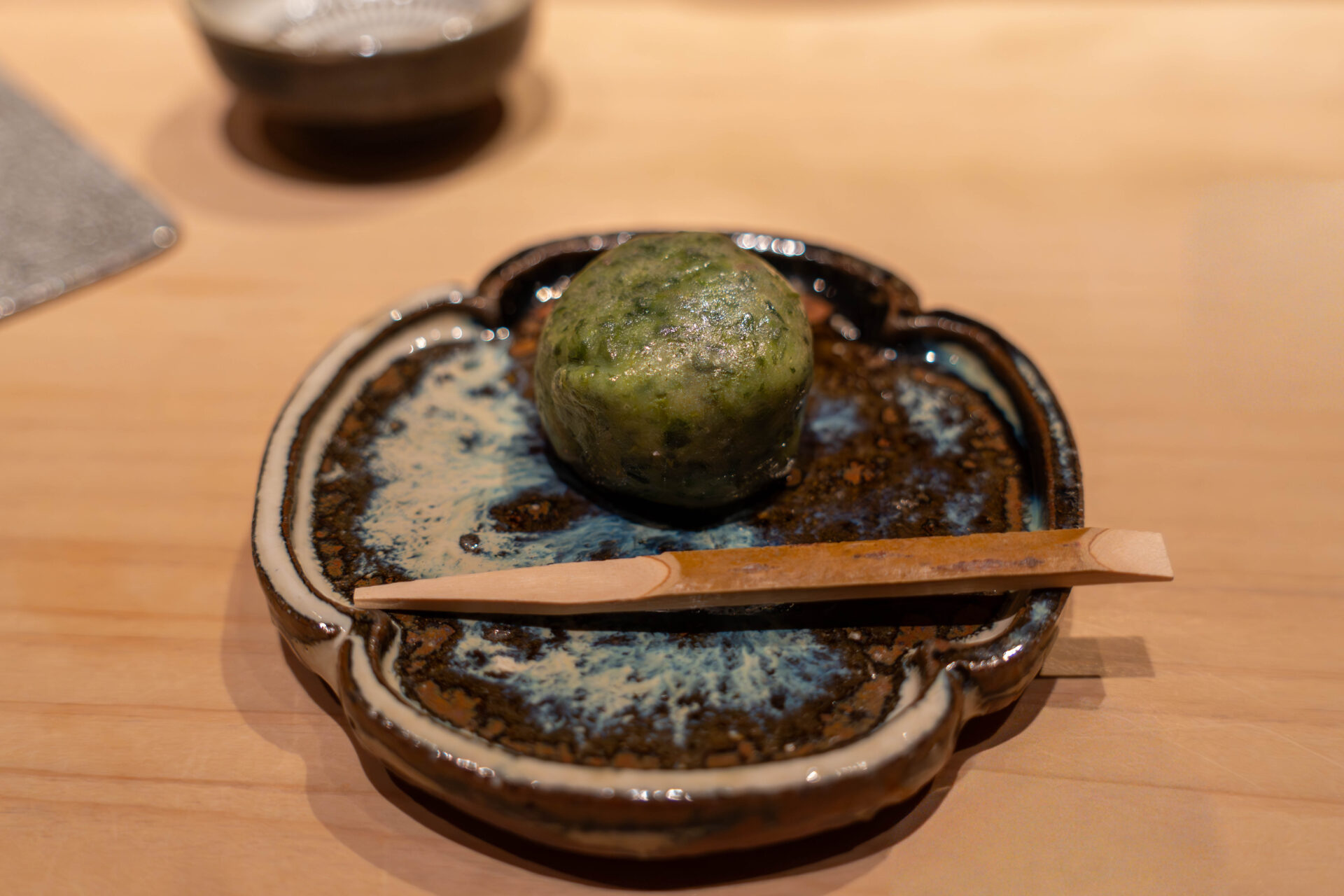
Overall Impressions
With an impressive variety of appetizers, each thoughtfully composed, the omakase at Sushi Yasukichi offers value far beyond sushi alone. The flow from start to finish is carefully structured, naturally heightening the appetite and interest with every course. Each piece of sushi was balanced in flavor and texture, showcasing both precision and harmony.
The sake pairing was equally remarkable—the interplay between aroma and umami amplified the pleasure of each bite. The chef’s sincerity and refined sense were evident throughout the evening.
Though the atmosphere carries quiet formality, Chef Shiiya’s warm and gentle personality softens the air, allowing guests to relax and fully immerse themselves in the experience. The flow of food, sake, conversation, and space together created a truly memorable and fulfilling time.
—From appetizers to nigiri, every element resonated with honesty and taste, leaving both the heart and palate deeply satisfied.
Reservations & Access
How to Reserve
-
Phone reservations only: 092-437-8111
-
With only 6–7 counter seats , early booking is highly recommended. Reservations are accepted up to two months in advance.
-
Omakase course only.
Access
-
Address: 4-3-11 Hakataekimae, Hakata-ku, Fukuoka City, Fukuoka Prefecture
-
Nearest station: JR Hakata Station, about 5–7 minutes’ walk from the Hakata Exit.
-
Though conveniently located, it sits quietly along a side street—check maps or signs to find it easily.
Opening Hours
-
Two seatings: 18:00–20:00 and 20:30–22:30.
-
Closed on Sundays; irregular holidays on national holidays.
-
Average price: around ¥20,000–30,000 per person for dinner.
- TAGS

